Psion 7545MBWP GSM/GPRS/UMTS/HSPA Module User Manual Omnii Hand Held Computer
Psion Inc GSM/GPRS/UMTS/HSPA Module Omnii Hand Held Computer
Psion >
Contents
user manual I
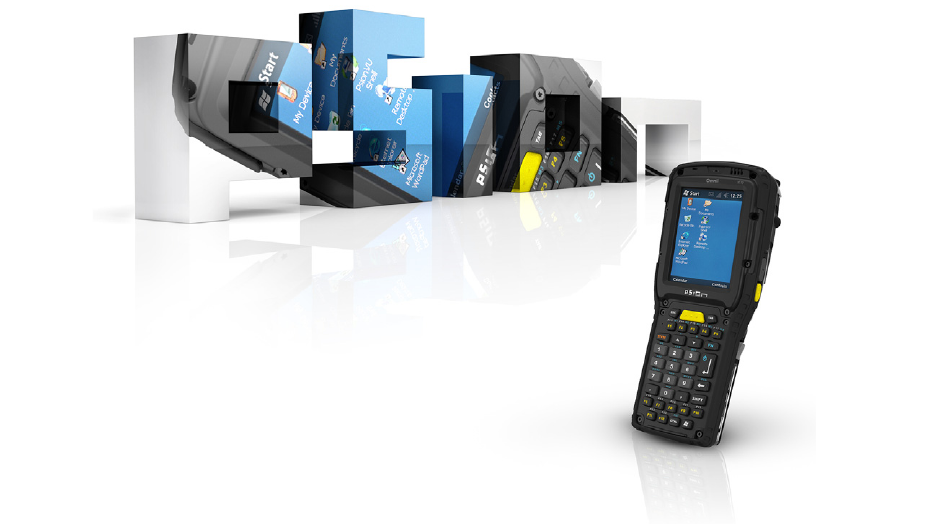
OMNII
HAND-HELD COMPUTER
User Manual
(Windows® Embedded CE 6.0)
October 4, 2011
Part No. 8000211.B
ISO 9001 Certified
Quality Management System
Regulatory Draft

This user manual supports Model Numbers:
• 7545MBW
• 7545MBWM
• 7545MBWP
• FCC ID: GM37545MBW, GM37545MBWM and GM37545MBWP
© Copyright 2011 by Psion Inc.
2100 Meadowvale Boulevard, Mississauga, Ontario, Canada L5N 7J9
http://www.psion.com
This document and the information it contains is the property of Psion Inc. This document is not to be
used, reproduced or copied, in whole or in part, except for the sole purpose of assisting in proper use of
Psion manufactured goods and services by their rightful owners and users. Any other use of this docu-
ment is prohibited.
Disclaimer
Every effort has been made to make this material complete, accurate, and up-to-date. In addition, changes
are periodically incorporated into new editions of the publication.
Psion Inc. reserves the right to make improvements and/or changes in the product(s) and/or the pro-
gram(s) described in this document without notice, and shall not be responsible for any damages
including, but not limited to, consequential damages, caused by reliance on the material presented.
Psion, the Psion logo, and the names of other products and services provided by Psion are trademarks of
Psion Inc.
Windows® and the Windows Logo are trademarks or registered trademarks of Microsoft Corporation in
the United States and/or other countries.
The Bluetooth® word mark and logos are owned by Bluetooth SIG, Inc. and any use of such marks by Psion
Inc. is under license.
All trademarks used herein are the property of their respective owners.
Regulatory Draft

Return-To-Factory Warranty
Psion Inc. provides a return to factory warranty on this product for a period of twelve (12) months in accor-
dance with the Statement of Limited Warranty and Limitation of Liability provided at:
www.psion.com/warranty
The warranty on Psion manufactured equipment does not extend to any product that has been tampered
with, altered, or repaired by any person other than an employee of an authorized Psion service organiza-
tion. See Psion terms and conditions of sale for full details.
Service and Information
Psion provides a complete range of product support services and information to its customers worldwide.
Services include technical support and product repairs. To locate your local support services, please go to:
www.psion.com/service-and-support.htm
To access further information on current and discontinued products, please go to our Teknet site and log in
or tap on “Not Registered?”, depending on whether you have previously registered for Teknet:
http://community.psion.com/support
A section of archived product information is also available online:
http://www.psion.com/products
Important: Psion warranties take effect on the date of shipment.
Regulatory Draft
Regulatory Draft

Psion Omnii Hand-Held Computer User Manual i
TA B L E O F
CONTENTS
Chapter 1: Introduction
1.1 About the User Manual.............................................................................................3
1.2 Text Conventions....................................................................................................4
1.3 Overview of Omnii Hand-Held Computer .........................................................................4
1.4 Regulatory Labels...................................................................................................7
Chapter 2: Basic Operation
2.1 Omnii Features.......................................................................................................11
2.2 Omnii Modules Available............................................................................................13
2.3 Documents Available ...............................................................................................13
2.4 Preparing Omnii for Operation.....................................................................................14
2.4.1 The Battery.................................................................................................14
2.5 Switching Omnii On and Off........................................................................................15
2.6 Resetting Omnii .....................................................................................................15
2.6.1 Performing a Warm Reset ................................................................................16
2.6.2 Performing a Cold Reset..................................................................................16
2.6.3 Performing a Clean Start .................................................................................16
2.6.4 Boot to BooSt..............................................................................................16
2.6.5 Performing a Hard Reset..................................................................................16
2.7 Attaching Carrying Accessories....................................................................................17
2.8 Calibrating the Touchscreen .......................................................................................17
2.9 Imager and Scanner Options.......................................................................................17
2.10 Connectivity .........................................................................................................17
2.11 Data Transfer ........................................................................................................17
2.12 Voice Communication...............................................................................................17
Chapter 3: Getting To Know Your Omnii
3.1 Operating System...................................................................................................21
3.2 Battery Details.......................................................................................................21
3.2.1 Battery Safety..............................................................................................21
3.2.2 Battery Swap Time ........................................................................................21
3.2.3 Charging the Battery......................................................................................21
3.3 The Keyboard........................................................................................................22
3.3.1 Regular Keys...............................................................................................22
3.3.2 Modifier Keys...............................................................................................23
3.3.2.1 Activating Modifier Keys ......................................................................24
3.3.2.2 Locking Modifier Keys.........................................................................24
3.3.3 Function Keys and Macro Keys...........................................................................25
3.3.3.1 Function Keys...................................................................................25
3.3.3.2 Macro Keys .....................................................................................25
3.3.4 Numeric Keyboards—Accessing Alpha Keys.............................................................25
3.3.5 The Keypad Backlight .....................................................................................26
3.4 The Display...........................................................................................................26
3.4.1 Adjusting the Display Backlight ..........................................................................26
3.4.2 Calibrating the Touchscreen..............................................................................26
Regulatory Draft

Table of Contents
Psion Omnii Hand-Held Computer User Manual
ii
3.5 Indicators ............................................................................................................ 27
3.5.1 LEDs ........................................................................................................ 27
3.5.1.1 Battery Charge Status LED ................................................................... 28
3.5.1.2 Operating System Status LED................................................................ 28
3.5.1.3 Radio Status LED .............................................................................. 28
3.5.1.4 Scanner Status LED ........................................................................... 28
3.5.2 Onscreen Indicators....................................................................................... 29
3.5.3 Audio Indicators ........................................................................................... 30
3.5.4 Vibrations ..................................................................................................30
3.6 Inserting the microSD Card and SIM Card........................................................................ 30
3.6.1 Inserting the Cards........................................................................................ 30
3.7 Scanners and Imagers.............................................................................................. 31
3.7.1 Basic Scanner Operations ................................................................................ 32
3.7.2 Scanning Techniques......................................................................................32
3.7.3 Scanner Status LED, Sounds, and Vibrations........................................................... 32
3.7.4 Troubleshooting ........................................................................................... 32
3.7.5 Operating One Dimensional (1D) Internal Laser Scanners............................................. 33
3.7.6 Operating Internal Two Dimensional (2D) Imagers..................................................... 33
3.8 Windows Embedded CE 6.0........................................................................................ 33
3.8.1 Navigating in Windows Embedded CE and Applications............................................... 33
3.8.1.1 Navigating Using a Touchscreen............................................................. 34
3.8.1.2 Navigating Using the Keyboard .............................................................. 34
3.8.2 The Windows Classic Shell Startup Desktop............................................................ 34
3.8.2.1 The Taskbar .................................................................................... 35
3.8.2.2 The Start Menu ................................................................................ 36
3.9 The PsionVU Desktop Shell ........................................................................................ 41
3.9.1 Restoring the Windows Classic Shell .................................................................... 43
3.10 General Maintenance............................................................................................... 43
3.10.1 Caring for the Touchscreen............................................................................... 43
3.10.2 Cleaning Omnii............................................................................................. 44
Chapter 4: Configuration
4.1 Overview of Software............................................................................................... 49
4.1.1 Psion Software Advantage................................................................................ 49
4.1.2 Microsoft Software........................................................................................ 49
4.2 The Control Panel................................................................................................... 49
4.2.1 Control Panel Icons........................................................................................ 50
4.3 App Launch Keys.................................................................................................... 53
4.4 Bluetooth® Setup................................................................................................... 54
4.4.1 Paired ...................................................................................................... 55
4.4.2 Device ...................................................................................................... 56
4.4.2.1 Discovering and Removing Devices.......................................................... 56
4.4.2.2 Filtering By Class of Device (COD)............................................................ 56
4.4.2.3 Device Pop-up Menu........................................................................... 57
4.4.2.4 Pairing a Device................................................................................ 57
4.4.3 Servers .....................................................................................................59
4.4.4 Mode ....................................................................................................... 59
4.4.5 About ...................................................................................................... 60
4.4.6 The Bluetooth GPRS WAN Connection.................................................................. 60
4.5 Certificates .......................................................................................................... 63
Regulatory Draft

Psion Omnii Hand-Held Computer User Manual iii
Table of Contents
4.6 Data Transfer between Omnii and a PC .......................................................................... 64
4.6.1 Uploading Data in a Docking Station .................................................................... 64
4.6.2 Using Microsoft ActiveSync .............................................................................. 64
4.6.3 Using Windows Mobile Device Center ................................................................... 65
4.7 Display Properties ..................................................................................................65
4.7.1 Background................................................................................................ 65
4.7.2 Appearance................................................................................................ 65
4.7.3 Backlight................................................................................................... 66
4.8 Dr. Debug ............................................................................................................66
4.8.1 Status....................................................................................................... 67
4.8.2 Settings..................................................................................................... 67
4.8.3 Utilities .....................................................................................................68
4.9 Error Reporting ..................................................................................................... 68
4.10 GPS (Global Positioning System) Settings........................................................................ 68
4.10.1 Power....................................................................................................... 69
4.10.2 Profiles ..................................................................................................... 69
4.10.3 Programs................................................................................................... 69
4.10.4 AGPS........................................................................................................ 70
4.10.5 Info.......................................................................................................... 71
4.11 Imager & Camera Settings ......................................................................................... 71
4.12 Input Panel........................................................................................................... 72
4.12.1 Keyboard Properties......................................................................................73
4.12.1.1 Key Repeat ..................................................................................... 73
4.12.1.2 Keyboard Backlight............................................................................ 74
4.12.1.3 Keyboard One Shot Modes.................................................................... 75
4.12.1.4 Keyboard Macro Keys .........................................................................75
4.12.1.5 Unicode Mapping .............................................................................. 77
4.12.1.6 Scancode Remapping ......................................................................... 78
4.12.1.7 Lock Sequence................................................................................. 80
4.13 Manage Triggers .................................................................................................... 81
4.13.1 Trigger Mappings.......................................................................................... 81
4.13.2 Add and Edit Trigger Mapping............................................................................ 82
4.14 Microphone .........................................................................................................83
4.15 Open TekTerm....................................................................................................... 84
4.16 PartnerUp............................................................................................................ 84
4.17 Pocket PC Compatibility . ...........................................................................................85
4.18 Power Properties.................................................................................................... 85
4.18.1 Battery Capacity........................................................................................... 85
4.18.2 Power Saving Suspend.................................................................................... 86
4.18.3 Suspend Threshold and Estimated Battery Backup.................................................... 87
4.18.4 Advanced .................................................................................................. 87
4.18.5 Built-in Devices ............................................................................................88
4.18.6 Battery Health............................................................................................. 88
4.19 Psion Camera........................................................................................................ 90
4.19.1 Using the Camera ......................................................................................... 90
4.19.2 Moving Photos to Omnii .................................................................................. 91
4.19.3 Opening a Photo........................................................................................... 91
4.19.4 Deleting a Photo........................................................................................... 92
4.19.5 Using the Video Recorder................................................................................. 92
4.20 PsionVU Access..................................................................................................... 93
Regulatory Draft

Table of Contents
Psion Omnii Hand-Held Computer User Manual
iv
4.20.1 Administrator Password ..................................................................................93
4.20.2 Shell Settings.............................................................................................. 94
4.20.3 Restrictions ................................................................................................ 96
4.20.4 Control Panel Settings .................................................................................... 97
4.20.5 Import/Export to File...................................................................................... 97
4.21 Remote Desktop Connection ...................................................................................... 98
4.22 Scanners.............................................................................................................98
4.22.1 Barcodes ................................................................................................... 99
4.22.1.1 Scanner.........................................................................................99
4.22.1.2 Restoring Default Settings.................................................................... 99
4.22.2 Options ..................................................................................................... 100
4.22.2.1 Double Click Parameters...................................................................... 101
4.22.2.2 Display Parameters............................................................................ 101
4.22.2.3 Data Handling.................................................................................. 102
4.22.3 Translations ............................................................................................... 102
4.22.3.1 Case Rules......................................................................................104
4.22.4 Ports ....................................................................................................... 104
4.22.4.1 Port Replicator Port A (COM5) and Port B (COM6)......................................... 104
4.23 Storage Manager.................................................................................................... 106
4.23.1 Formatting a Memory Card............................................................................... 106
4.23.2 Creating Partitions........................................................................................ 106
4.23.3 Partition Management.................................................................................... 107
4.24 Stylus Properties.................................................................................................... 109
4.24.1 Double-Tap .................................................................................................109
4.24.2 Calibration.................................................................................................. 109
4.24.3 Touch....................................................................................................... 110
4.25 System Properties .................................................................................................. 110
4.26 Total Recall ..........................................................................................................111
4.26.1 Creating a Backup Profile................................................................................. 111
4.26.2 Restoring a Profile......................................................................................... 113
4.26.3 Viewing a Profile........................................................................................... 113
4.26.4 Deleting a Profile.......................................................................................... 114
4.27 TweakIt............................................................................................................... 114
4.27.1 Advanced...................................................................................................114
4.27.1.1 Advanced CE Services Settings .............................................................. 114
4.27.1.2 Advanced Interface and Network Settings..................................................115
4.27.1.3 Advanced Services Settings.................................................................. 115
4.27.2 User.........................................................................................................116
4.27.2.1 User Display Settings.......................................................................... 116
4.27.3 TweakIt ..................................................................................................... 116
4.28 Voice – Using the Phone Dialer .................................................................................... 116
4.28.1 Dialing a Number.......................................................................................... 117
4.28.2 Voice Menu................................................................................................. 117
4.28.3 File Menu – Phonebook Management....................................................................119
4.29 Volume & Sounds Properties ...................................................................................... 120
4.29.1 Volume Adjustments......................................................................................121
4.29.2 Sound Adjustments ....................................................................................... 121
4.30 Wi-Fi Config.......................................................................................................... 121
4.30.1 Wi-Fi Config: Status ....................................................................................... 122
4.30.2 Wi-Fi Config: Configure ................................................................................... 122
Regulatory Draft

Psion Omnii Hand-Held Computer User Manual v
Table of Contents
4.30.2.1 Authentication Mode.......................................................................... 123
4.30.2.2 Encryption...................................................................................... 124
4.30.2.3 EAP ............................................................................................. 124
4.30.2.4 Verify Server Certificate ...................................................................... 125
4.30.2.5 Enable OPMK................................................................................... 125
4.30.2.6 Connecting the Wireless Network............................................................ 125
4.30.3 Configuring TCP/IP........................................................................................ 126
4.30.3.1 IP Address...................................................................................... 126
4.30.3.2 Name Server ................................................................................... 128
4.30.4 Wi-Fi Config: Advanced ................................................................................... 128
4.30.5 Monitoring the Network Connection..................................................................... 129
Chapter 5: Accessories
5.1 Pistol Grips........................................................................................................... 133
5.1.1 Removing the Trigger Cover.............................................................................. 133
5.1.2 Attaching the Pistol Grip.................................................................................. 133
5.2 Carrying and Protective Accessories ............................................................................. 134
5.2.1 Attaching the Hand Strap - Model ST6025 ............................................................. 135
5.2.2Protective Carrying Case - Model ST6090.............................................................. 137
5.2.3Hard Shell Holster - Model ST6055...................................................................... 137
5.3 Power Adaptor Options.............................................................................................137
5.3.1 Snap Modules..............................................................................................137
5.3.2 AC Wall Adaptor - Model ST1050-1....................................................................... 138
5.3.3 Vehicle Power Outlet Adaptor - Model ST3113 ..........................................................139
5.4 Chargers and Docking Stations: General Information........................................................... 140
5.4.1 Important Charger Safety Instructions.................................................................. 140
5.4.2 Charging the Battery......................................................................................140
5.4.3 Installation—Chargers and Docking Stations............................................................140
5.4.4 Operator Controls......................................................................................... 140
5.4.5 Power Consumption Considerations.....................................................................141
5.5 Desktop Docking Stations - Models ST4002 and ST4003 ...................................................... 141
5.5.1 Charging a Battery Installed in Omnii ................................................................... 142
5.5.2 Indicators...................................................................................................143
5.5.3 Operation ..................................................................................................143
5.5.3.1 Charging the Omnii Battery................................................................... 143
5.5.3.2 Charging the Spare Battery...................................................................143
5.5.4 Cleaning the Desktop Docking Station .................................................................. 143
5.5.5 Troubleshooting ........................................................................................... 144
5.5.5.1 Docking station does not seem to power on.................................................144
5.5.5.2 Omnii charge indicator LED stays off......................................................... 144
5.5.5.3 Omnii charge indicator LED is red............................................................ 144
5.5.5.4 Spare battery LED is red with a battery installed...........................................144
5.5.5.5 Spare battery LED does not turn on when a battery is installed. ......................... 144
5.6 Quad Docking Station – Model No. ST4004...................................................................... 145
5.6.1 Operator Controls......................................................................................... 145
5.6.2 Indicators...................................................................................................145
5.6.3 Quad Docking Station Operation......................................................................... 145
5.6.3.1 Charging the Omnii Battery...................................................................145
5.6.3.2 Installation...................................................................................... 145
Regulatory Draft

Table of Contents
Psion Omnii Hand-Held Computer User Manual
vi
5.6.3.3 Connecting to the Ethernet Network........................................................ 146
5.6.4 Cleaning the ST4004 ..................................................................................... 146
5.6.5 Troubleshooting ........................................................................................... 146
5.6.5.1 Omnii Charge Indicator LED Stays Off.......................................................146
5.6.5.2 Power LED Does Not Light Up................................................................ 146
5.6.5.3 Omnii Charge LED Flashes Yellow............................................................ 146
5.6.5.4 Omnii Charge Indicator LED Flashes Red.................................................... 147
5.6.5.5 Powered Adaptor LED Stays Off .............................................................147
5.7 Vehicle Cradles - Models ST1000 and ST1002 ................................................................... 147
5.7.1 Vehicle Cradle Mounting Recommendations ........................................................... 148
5.7.2 Wiring Guidelines.......................................................................................... 149
5.7.3 Using the Vehicle Cradle.................................................................................. 149
5.7.4 Maintaining the Vehicle Cradle........................................................................... 149
5.7.5 Powered Vehicle Cradle Installation in High Voltage Vehicles ........................................ 149
5.7.5.1 Extreme Wet Environments................................................................... 149
5.7.6 Powered Cradle Installation ..............................................................................150
5.7.7 Wiring Vehicle Power to the Cradle...................................................................... 150
5.8 Battery Charger (6-Slot) - Model ST3006 ........................................................................ 151
5.8.1 Installation ................................................................................................. 151
5.8.2 Operator Controls......................................................................................... 151
5.8.3 Charge Indicators.......................................................................................... 152
5.8.4 Charging Batteries ........................................................................................ 152
5.8.5 Troubleshooting ........................................................................................... 152
5.8.5.1 Improper Battery Storage..................................................................... 152
5.8.5.2 Power LED Does Not Light Up................................................................ 152
5.8.5.3 Indicator Does Not Light When Battery Installed........................................... 152
Appendices
Appendix A: Port Pinouts
A.1 Omnii Docking Connector.......................................................................................... A-3
A.2 Snap Modules Connectors.......................................................................................... A-4
A.3 Cable Connectors for Vehicle Cradle Model ST1002.............................................................A-5
A.4 Omnii Battery Contacts.............................................................................................A-6
Appendix B: Imager & Camera Settings
B.1 Required Applets.................................................................................................... D-3
B.2 Presets .............................................................................................................. D-3
B.2.1 Predefined Presets........................................................................................D-3
B.2.2 Barcode Predefined Presets (Barcoding Menu)......................................................... D-3
B.2.2.1 Barcode Decoding Symbology Predefined Presets.........................................D-4
B.2.2.2 Barcode Decoding Camera Predefined Presets............................................. D-4
B.2.3 Image Capture Predefined Presets (Imaging Menu) ...................................................D-4
B.3 Using the Imagers Applet .......................................................................................... D-5
B.3.1 Configuring the Image Capture Presets (Imaging Menu).............................................. D-5
B.3.1.1 Selecting a Camera............................................................................ D-5
B.3.1.2 Setting the Active Preset ..................................................................... D-5
B.3.1.3 Viewing a Preset............................................................................... D-6
B.3.1.4 Creating a Custom Preset..................................................................... D-6
Regulatory Draft

Psion Omnii Hand-Held Computer User Manual vii
Table of Contents
B.3.1.5 Modifying a Custom Preset...................................................................D-6
B.3.1.6 Removing a Custom Preset................................................................... D-7
B.3.2 Configuring the Barcode Decoding Camera Presets (Barcoding Menu).............................. D-7
B.3.2.1 Selecting a Camera............................................................................ D-8
B.3.2.2 Setting the Active Preset ..................................................................... D-8
B.3.2.3 Viewing a Preset............................................................................... D-8
B.3.2.4 Creating a Custom Preset..................................................................... D-9
B.3.2.5 Modifying a Custom Preset...................................................................D-9
B.3.2.6 Removing a Custom Preset................................................................... D-10
B.3.3 Configuring the Barcode Decoding Symbologies (Barcoding Menu) ................................. D-10
B.3.3.1 Setting the Active Preset ..................................................................... D-11
B.3.3.2 Viewing a Preset............................................................................... D-11
B.3.3.3 Creating a Custom Preset..................................................................... D-11
B.3.3.4 Modifying a Custom Preset................................................................... D-12
B.3.3.5 Removing a Custom Preset................................................................... D-13
B.3.4 Barcoding Menu – Configuring Symbologies............................................................ D-13
B.3.4.1 Symbology Settings ........................................................................... D-13
B.3.5 Filter Menu – Manipulating Barcode Data ............................................................... D-13
B.3.5.1 Modifying a Barcode Setting.................................................................. D-13
B.3.6 Translation Menu – Configuring Rules...................................................................D-14
B.3.7 Advanced Menu............................................................................................D-15
B.3.7.1 File Locations for Captured Images..........................................................D-15
B.3.7.2 Configuring Triggers........................................................................... D-15
B.4 Barcode Symbologies............................................................................................... D-16
B.4.1 Imager Barcode Symbologies............................................................................ D-17
B.4.2 Color Camera Barcode Symbologies..................................................................... D-18
Appendix C: Scanner Settings
C.1 Barcode Settings.................................................................................................... C-3
C.1.1 Scanner Options........................................................................................... C-3
C.1.2 Restoring Default Settings................................................................................ C-3
C.2 Decoded (Internal) Scanners....................................................................................... C-4
C.2.1 Options.....................................................................................................C-5
C.2.2 Decoded (Internal) Advanced Options...................................................................C-5
C.2.3 Decoded (Internal) Data Options......................................................................... C-6
C.3 Decoded (HHP)...................................................................................................... C-7
C.4 Decoded (Intermec ISCP)........................................................................................... C-7
C.4.1 Decoded (ISCP) Options .................................................................................. C-7
C.4.2 Decoded (ISCP) Advanced Options...................................................................... C-8
C.5 Non-Decoded Scanners............................................................................................. C-9
C.5.1 Options..................................................................................................... C-10
Appendix D: Internal Imager & Scanner Specifications
D.1 SE955 Scanner...................................................................................................... D-3
D.1.1 SE955 Decode Zones ..................................................................................... D-3
D.2 SE1223LR - Long Range (Decoded) Scanner ..................................................................... D-4
D.2.1 SE 1223LR Decode Zone.................................................................................. D-4
D.3 SE1224HP - High Performance Scanner .......................................................................... D-5
D.3.1 SE1224HP Decode Zones ................................................................................. D-5
D.4 SE1524ER – Extended Range Scanner ............................................................................ D-6
Regulatory Draft

Table of Contents
Psion Omnii Hand-Held Computer User Manual
viii
D.4.1 SE1524ER Decode Zones ................................................................................. D-6
D.5 EV15 Imager......................................................................................................... D-7
D.5.1 EV15 Imager Decode Zone................................................................................ D-7
D.6 EA11 Decoded 2D Imager ........................................................................................... D-8
D.6.1 EA11 Typical Reading Distances........................................................................... D-8
D.7 EA20X Imager....................................................................................................... D-9
D.7.1 EA20X Typical Reading Distances ....................................................................... D-9
D.8 HHP 5080 Imager/Decoder........................................................................................ D-10
D.8.1 HHP 5080 Working Range ............................................................................... D-10
Appendix E: Omnii Specifications
E.1 The Omnii Hand-Held Computer (Model 7545) .................................................................. E-3
E.1.1 Hardware................................................................................................... E-3
E.1.2 Approvals................................................................................................... E-4
E.2 Lithium-ion Smart Battery 5000 mAh (ST3000)................................................................ E-5
E.3 Wireless Radios...................................................................................................... E-6
E.3.1 Cinterion MC75i GSM/GPRS/EDGE Radio............................................................... E-6
5.8.6 Cinterion PH8-P GSM/GPRS/EDGE Radio............................................................... 7
5.8.7 802.11a/b/g/n Radio ....................................................................................... 9
5.8.8 Bluetooth Radio............................................................................................ 10
Appendix F: Wireless Wide Area Network (WWAN) Settings
F.1 Wireless WAN........................................................................................................ F-3
F.1.1 Taskbar Icons .............................................................................................. F-3
F.1.2 Establishing a Connection................................................................................ F-3
F.1.2.1 Disconnecting From a Network............................................................... F-4
F.1.2.2 Shutting Down the Wireless WAN User Interface........................................... F-5
F.1.3 Advanced Information .................................................................................... F-5
F.1.3.1 Entering a PIN Number........................................................................ F-5
F.1.3.2 Error States .................................................................................... F-5
F.1.4 Tools Menu................................................................................................. F-6
F.1.4.1 Data Configuration ............................................................................ F-6
F.1.4.2 Security Configuration........................................................................ F-9
F.1.4.3 Network Configuration........................................................................ F-9
F.1.4.4 Driver Mode Configuration.................................................................... F-10
F.1.4.5 Modem Information ........................................................................... F-11
F.1.4.6 User Interface..................................................................................F-11
F.1.5 SMS Menu.................................................................................................. F-12
F.1.5.1 New ............................................................................................. F-12
F.1.5.2 Inbox............................................................................................F-12
F.1.5.3 Outbox.......................................................................................... F-13
F.1.5.4 SMS Configuration.............................................................................F-13
F.1.6 Voice........................................................................................................ F-13
F.2 Power Mode .........................................................................................................F-13
Appendix G: Wireless Zero Config Settings
G.1 Wireless Information................................................................................................ G-3
G.1.1 Wireless Statistics ........................................................................................ G-3
G.1.2 Wireless Information ..................................................................................... G-4
G.2 Assigning An IP Address ........................................................................................... G-6
Regulatory Draft

Psion Omnii Hand-Held Computer User Manual ix
Table of Contents
G.2.1 Name Server............................................................................................... G-6
G.3 Advanced Features..................................................................................................G-7
G.3.1 Rearranging Preferred Networks ........................................................................G-7
G.3.2 Deleting A Preferred Network............................................................................ G-7
G.3.3 Changing Network Properties............................................................................G-7
Index ...........................................................................................I
Regulatory Draft
Regulatory Draft

1
Psion Omnii Hand-Held Computer User Manual
1INTRODUCTION
INTRODUCTION 1
1.1 About the User Manual.....................................................3
1.2 Text Conventions.........................................................4
1.3 Overview of Omnii Hand-Held Computer...........................................4
1.4 Regulatory Labels........................................................7
Regulatory Draft
Regulatory Draft

Chapter 1: Introduction
About the User Manual
3
Psion Omnii Hand-Held Computer User Manual
1.1 About the User Manual
This User Manual describes how to configure, operate, and maintain the Psion Omnii Hand-Held Computer.
Chapter 1: Introduction
provides a basic overview of Omnii.
Chapter 2: Basic Operation
describes preparing Omnii for operation, including setting up your wireless network.
Chapter 3: Getting To Know Your Omnii
describes Omnii features, including how to charge and maintain the battery, the keyboard
features, the display, using the internal scanner, etc. Also describes the Microsoft® Win-
dows® Embedded CE 6.0 desktop and how to use it, and how to change the appearance and
actions of the desktop from Windows Classic Shell to the PsionVU Shell.
Chapter 4: Configuration
describes the Psion Software Advantage and Microsoft programs, and how to use them to
configure Omnii, along with scanners/imagers, Bluetooth, and so on. This chapter also intro-
duces you to the PsionVU program, which enables you to customize your computer settings,
remove or add shortcuts to the desktop and Control Panel, and lock down access to various
different components on the computer and the system tray icons for security. With PsionVU
and PsionVU Shell you can greatly enhance your User Experience.
Chapter 5: Accessories
describes the peripherals and accessories available for your Omnii computer.
Appendix A: Port Pinouts
describes the Omnii pinouts.
Appendix B: Imager & Camera Settings
describes in detail your imager’s settings.
Appendix C: Scanner Settings
details your barcode options.
Appendix D: Internal Imager & Scanner Specifications
lists the specifications for the Omnii scanners and imagers.
Appendix E: Omnii Specifications
lists the specifications for your Omnii computer, radios, and battery.
Appendix F: Wireless Wide Area Network (WWAN) Settings
describes WWAN configuration information.
Appendix G: Wireless Zero Config Settings
outlines the steps used to configure your radio using Windows Zero Config.
Regulatory Draft

Chapter 1: Introduction
Tex t Conven t i o ns
Psion Omnii Hand-Held Computer User Manual
4
1.2 Text Conventions
1.3 Overview of Omnii Hand-Held Computer
Omnii Hand-Held Computer is a modular, industrial hand-held computer. A variety of options are available
to suit applications in courier/delivery, field service, manufacturing facilities, material handling applications
in warehouses, ports and yards, with a focus on real time wireless data transactions. Barcode input method-
ologies are supported by a variety of available scanners. Optimization for specific operational environ-
ments is also supported with a wide range of peripheral options and carrying accessories.
Model Variants
• Omnii RT15 Hand-Held Computer (rugged) - Model 7545XC
• Omnii XT15 Hand-Held Computer (extremely rugged) - Model 7545XA
Platform
•Texas Instruments
® OMAP3® Processor, 800 MHz
• Flash Memory: configurable from 512 MB to 16 GB
•RAM 256 MB
Operating System
• Microsoft Windows Embedded CE 6.0
Bundled Applications
• Internet Explorer® 6
• Windows Mobile Device Center
•Wordpad
®, ActiveSync®
Supported Applications
•Open TekTerm
• Lockdown Browser
• Naurtech Browser
Device Management and Provisioning
• Mobile Control Centre (MCC)
• Wavelink Avalanche
• Total Recall / Registry Editor / Hermes
Note: Notes highlight additional helpful information.
Important: These statements provide particularly important instructions or additional infor-
mation that is critical to the operation of the equipment.
Warning: These statements provide critical information that may prevent physical injury,
equipment damage or data loss.
Note: Omnii Hand-Held Computer is a body worn device, and to maintain compliance with the FCC
RF exposure guidelines, use a Psion approved carrying case. Use of non-approved accessories
may violate FCC RF exposure guidelines.
Note: For product specifications, refer to Appendix E: “Omnii Specifications”.
Regulatory Draft

Chapter 1: Introduction
Overview of Omnii Hand-Held Computer
5
Psion Omnii Hand-Held Computer User Manual
User Interface
• Colour Touch Display 9.4 cm (3.7 in.) diagonal
- VGA/QVGA, 480 x 640 resolution
- High visibility version: superior sunlight visibility
- High Impact version: withstands 1.25 Joule impact
•Touchscreen
- Passive stylus or finger operation; pan and flick gestures supported
-Signature capture
•Keyboards
- Large selection of backlit keypads in both alpha and numeric formats. For a list of currently availa-
ble keyboard configurations, consult your Psion representative, or go to:
-http://www.psion.com/us/products/handheld/omniit10_accessories.htm
•Audio
- Beeper
- Rear speaker (optional)
- Integrated Microphone and PTT Speaker
- Supports walkie-talkie style Push-to-Talk over PTT Speaker; VoIP supported over both standard Wi-
Fi and PTT microphone/speaker.
• Vibration feedback available to indicate successful barcode scanning in noisy environments.
Wireless Communication
• Integrated 802.11b/g radio (CCX v4 certified)
• FIPS 140-2 support
• Internal Wi-Fi antenna
•Integrated Bluetooth® class II, V 2.0 + EDR
• Optional SIRF III GPS Receiver
The following figures illustrate the main features of Omnii —for detailed views, please see “Omnii Features”
on page 11.
Note: 802.11b/g and Bluetooth are available simultaneously.
Regulatory Draft
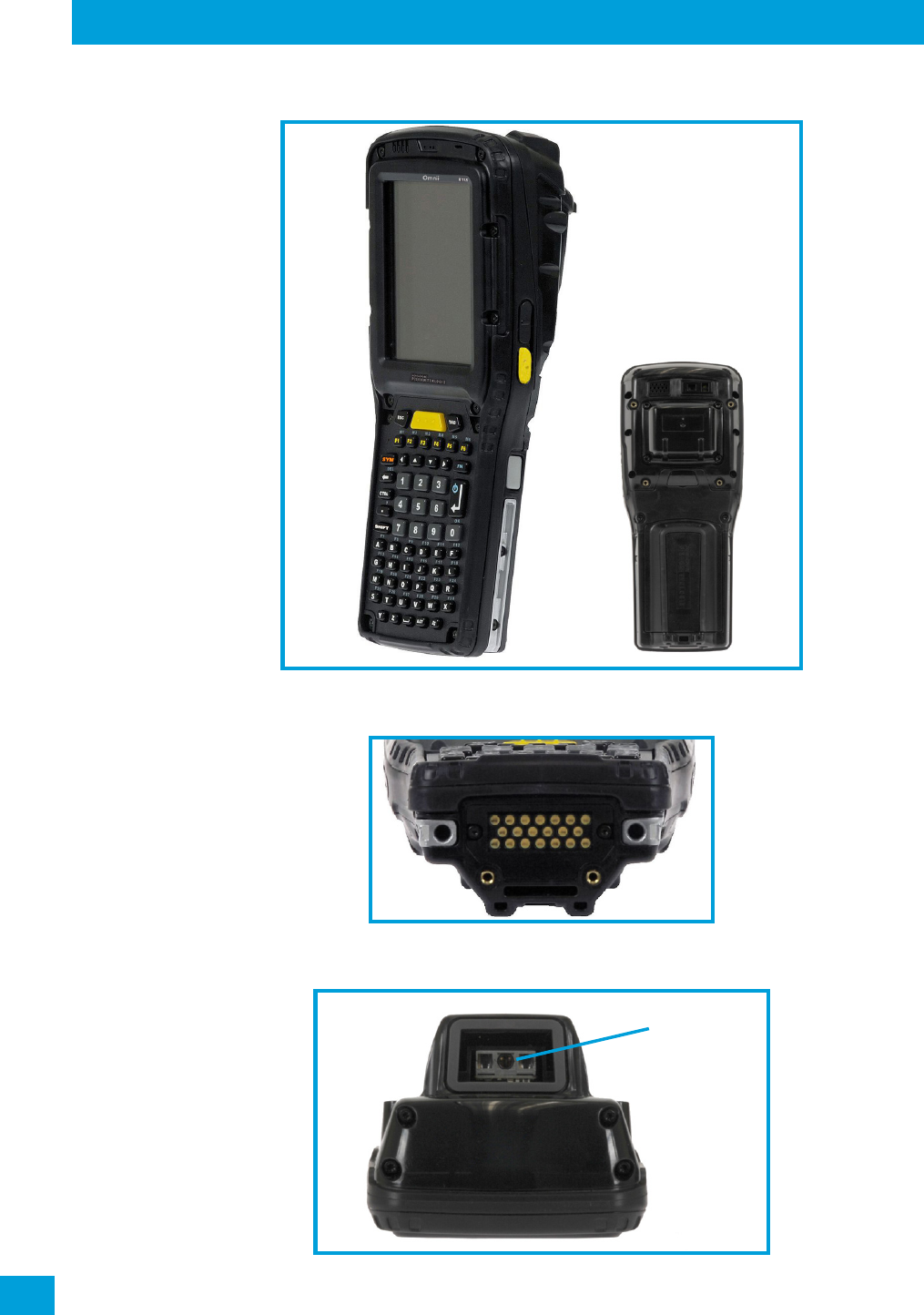
Chapter 1: Introduction
Overview of Omnii Hand-Held Computer
Psion Omnii Hand-Held Computer User Manual
6
Figure 1.1 Omnii RT15 Model with 59-Key Alpha ABC Keyboard
Figure 1.2 Bottom View (Docking Connector)
Figure 1.3 Top View (Scanner Window)
Laser Aperture
Regulatory Draft
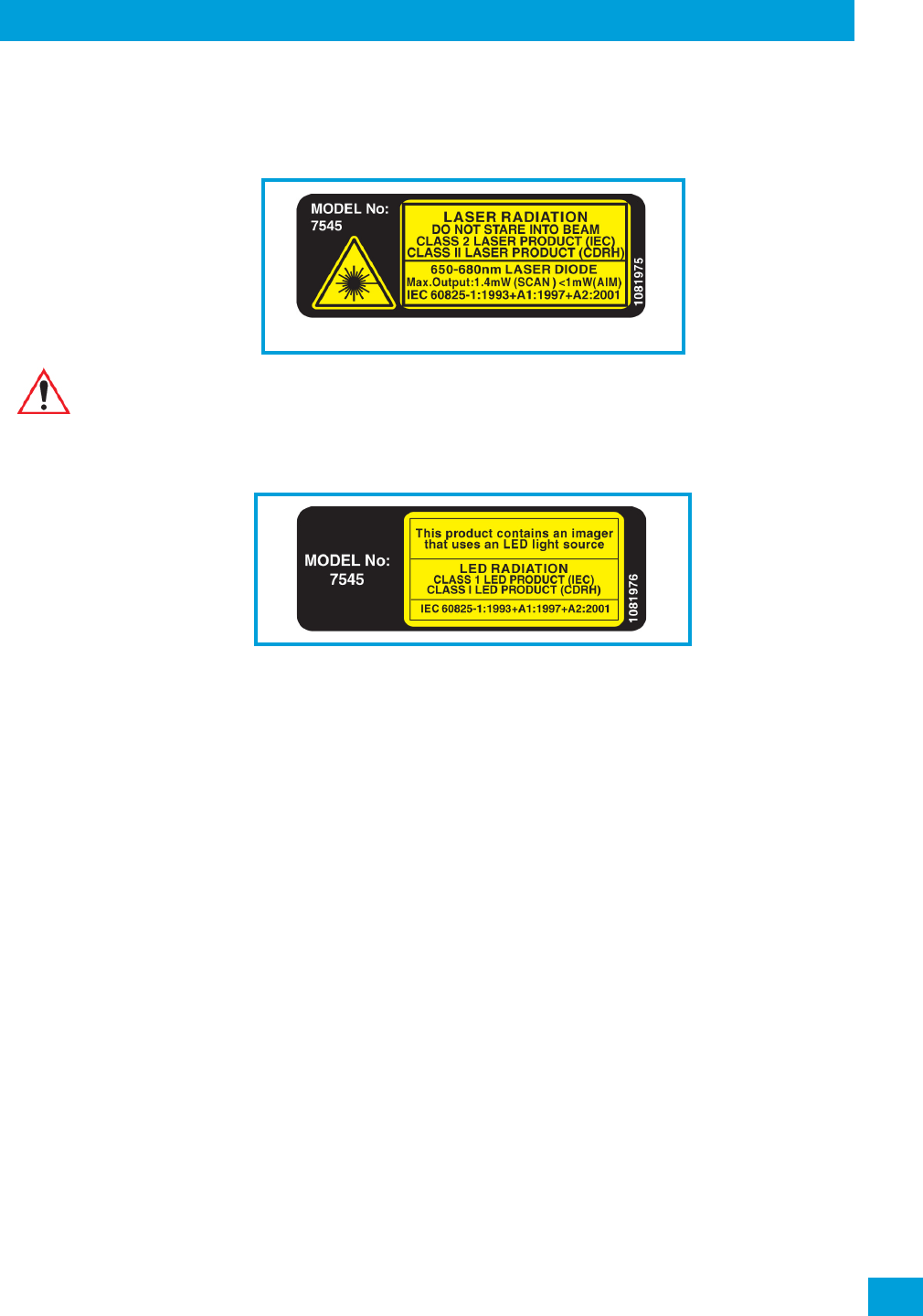
Chapter 1: Introduction
Regulatory Labels
7
Psion Omnii Hand-Held Computer User Manual
1.4 Regulatory Labels
Figure 1.4 Laser Warning Label
Figure 1.5 LED Radiation Notice Label
This label is affixed below the scanner window.
Warning: Using controls or adjustments or performing procedures other than those speci-
fied herein may result in hazardous radiation exposure.
Thi l b l i ffi d b l th i d
Regulatory Draft
Regulatory Draft

9
Psion Omnii Hand-Held Computer User Manual
2BASIC OPERATION
BAS IC O PER ATIO N 2
2.1 Omnii Features...........................................................11
2.2 Omnii Modules Available.................................................... 13
2.3 Documents Available...................................................... 13
2.4 Preparing Omnii for Operation................................................. 14
2.4.1 The Battery......................................................14
2.5 Switching Omnii On and Off.................................................. 15
2.6 Resetting Omnii......................................................... 15
2.6.1 Performing a Warm Reset............................................. 16
2.6.2 Performing a Cold Reset.............................................. 16
2.6.3 Performing a Clean Start.............................................. 16
2.6.4 Boot to BooSt .................................................... 16
2.6.5 Performing a Hard Reset.............................................. 16
2.7 Attaching Carrying Accessories................................................ 17
2.8 Calibrating the Touchscreen.................................................. 17
2.9 Imager and Scanner Options.................................................. 17
2.10Connectivity........................................................... 17
2.11 Data Transfer........................................................... 17
2.12Voice Communication...................................................... 17
Regulatory Draft
Regulatory Draft
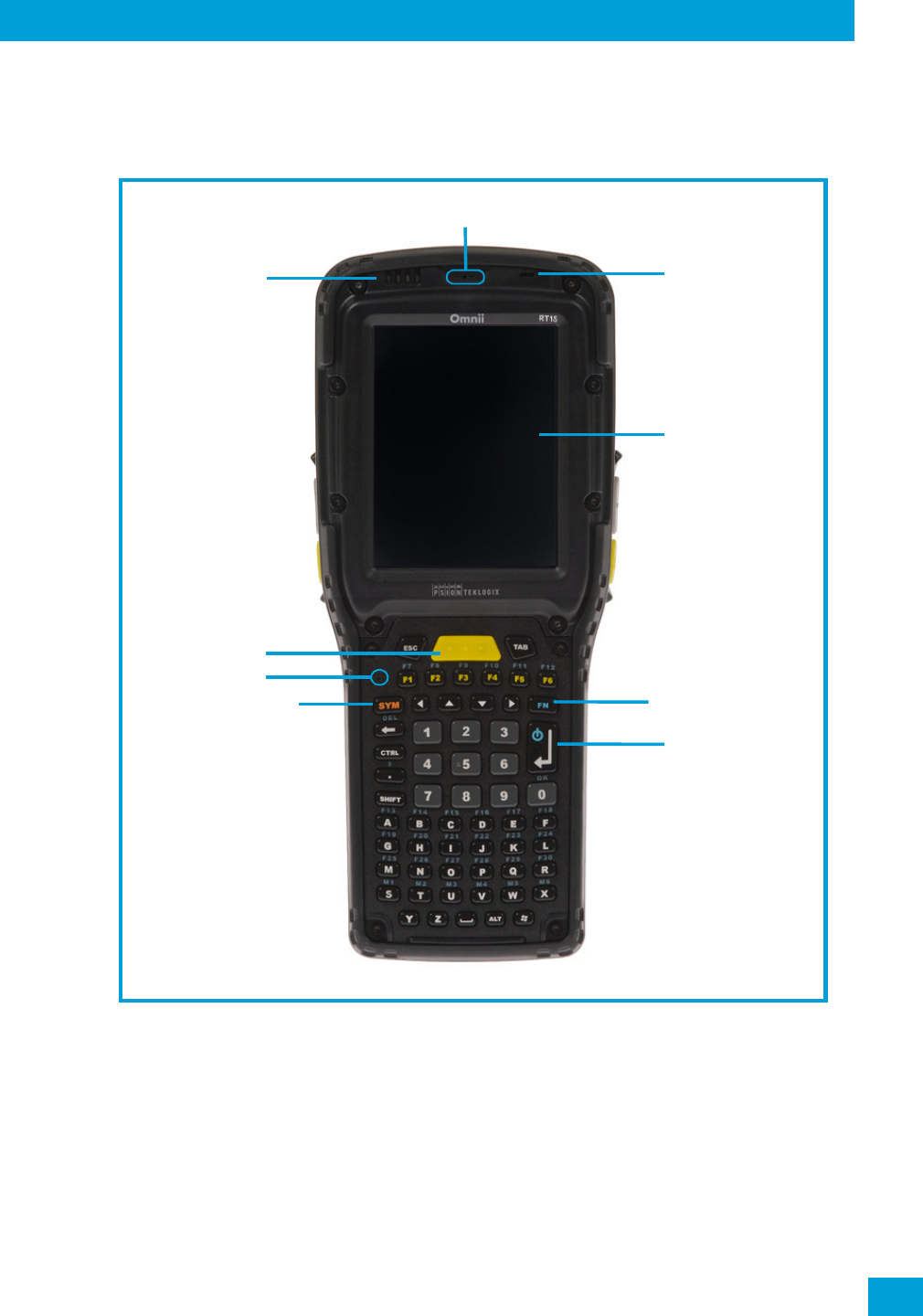
Chapter 2: Basic Operation
Omnii Features
11
Psion Omnii Hand-Held Computer User Manual
2.1 Omnii Features
Figure 2.1 Front View of Omnii RT15 Model with Alphanumeric Keyboard
Display
LEDs
ENTER/Power Key
FN Modifier Key
Symbol Modifier Key
Scan Key
Microphone
Speaker
Beeper
Regulatory Draft
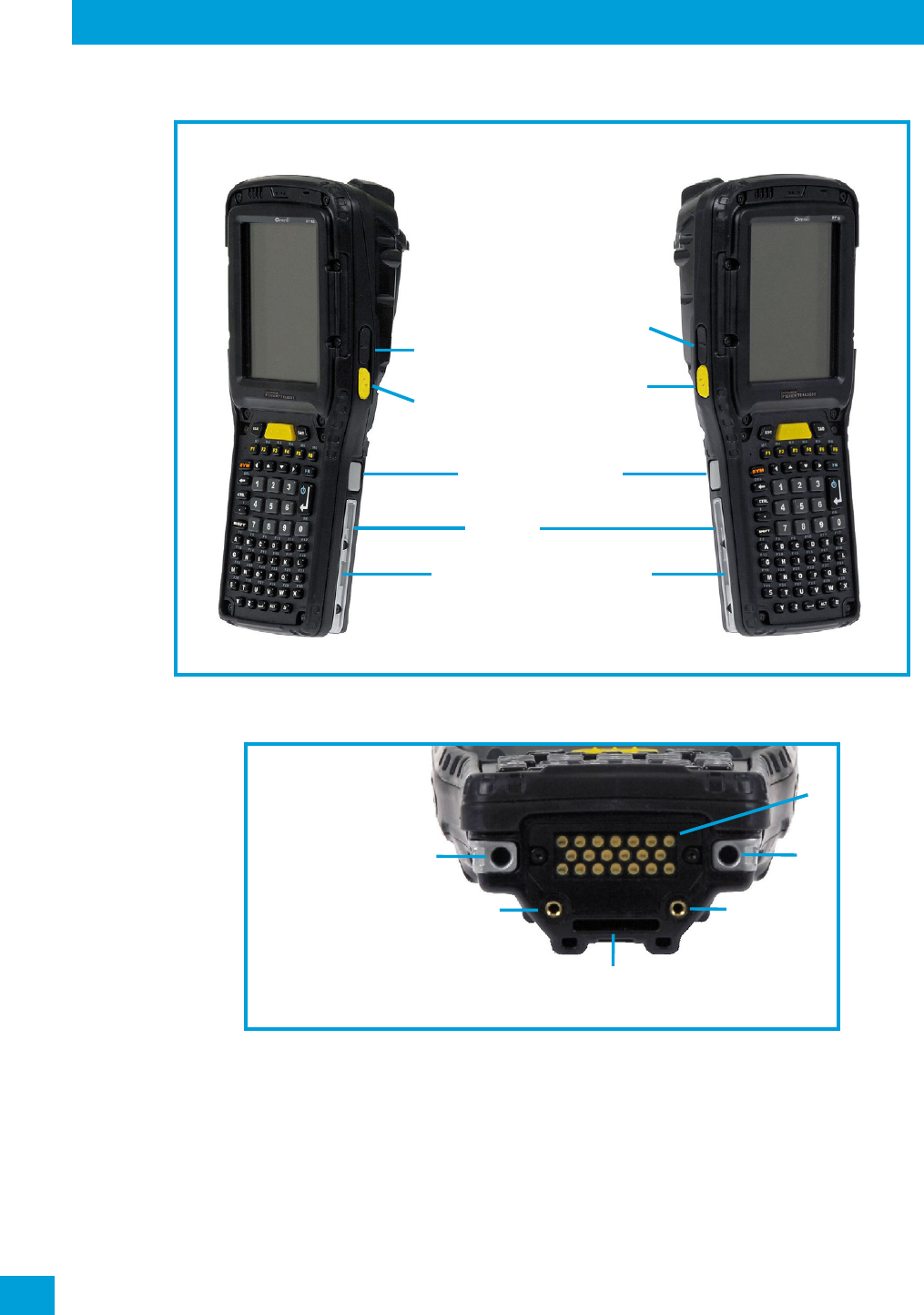
Chapter 2: Basic Operation
Omnii Features
Psion Omnii Hand-Held Computer User Manual
12
Figure 2.2 Side Views of Omnii RT15
Figure 2.3 Bottom View
Scan Button
Left Side
Right Side
Volume
ENTER Button
Vertical
Scroll Button
Slot for Snap Module Arm
Battery Release Latch
Side Rail
Rocker Button
1 - Docking Connector
1
2
2
3
3
4
2 - Alignment Pin Holes
3 - M2.5 Locking Screws
(for firmly attaching devices)
4 - Hand Strap Slot
Regulatory Draft
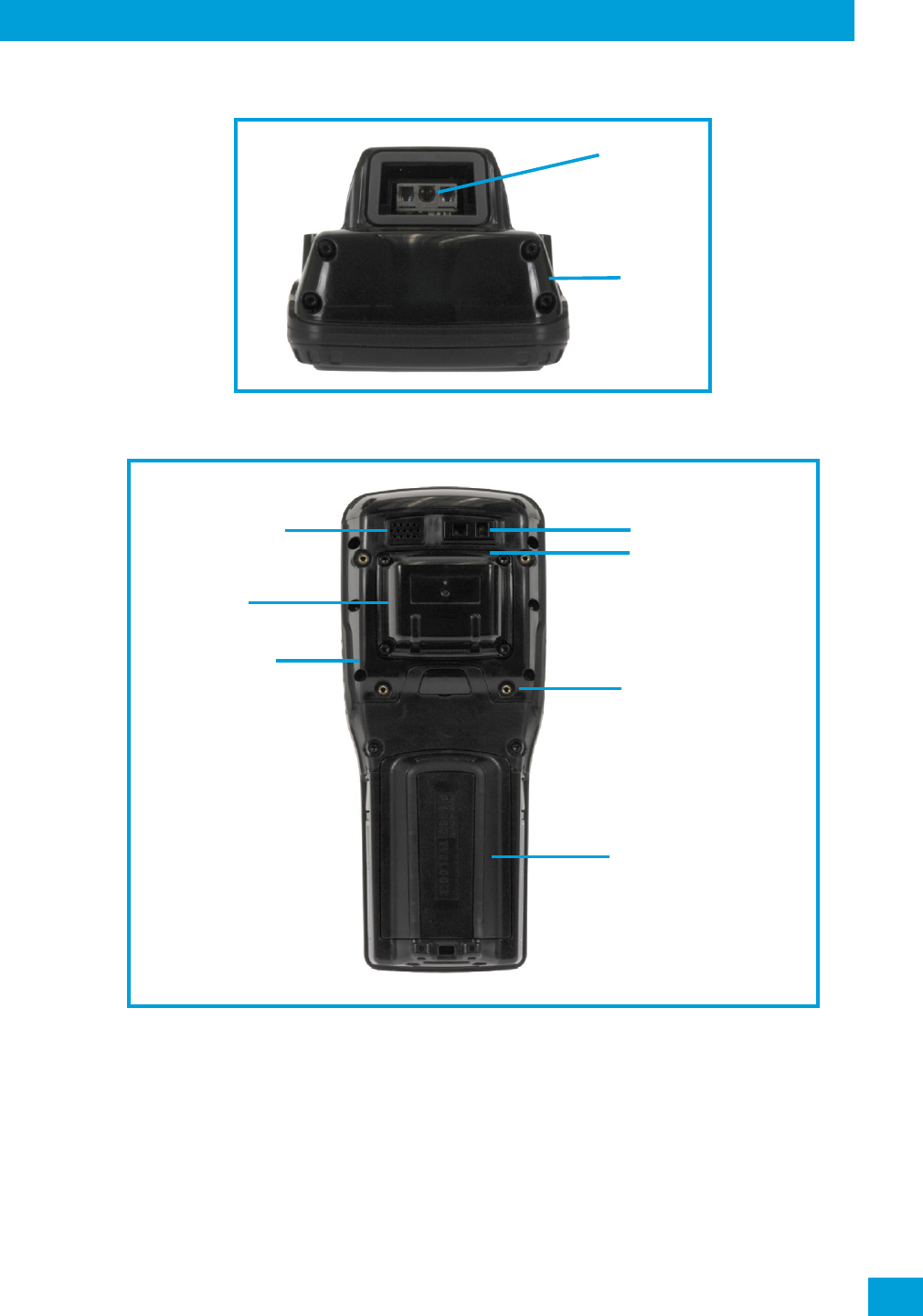
Chapter 2: Basic Operation
Omnii Modules Available
13
Psion Omnii Hand-Held Computer User Manual
Figure 2.4 Top View
Figure 2.5 Back View
2.2 Omnii Modules Available
To see a current list of Omnii accessories and modules, please go to the Psion website at:
http://www.psion.com/us/products/handheld/omniit10_accessories.htm
2.3 Documents Available
To see a current list of documents and download what you need, please go to the Knowledge Base on the
Psion Ingenuity Working community website:
http://community.psion.com/knowledge/w/knowledgebase/product-manuals.aspx
Aperture
Laser
End-Cap
Scanner Window
Battery Pack
Camera Aperture
Rear PTT Speaker
Scanner Pod
Pistol Grip
Attachment Screws (4)
Expansion Back
(optional)
Regulatory Draft
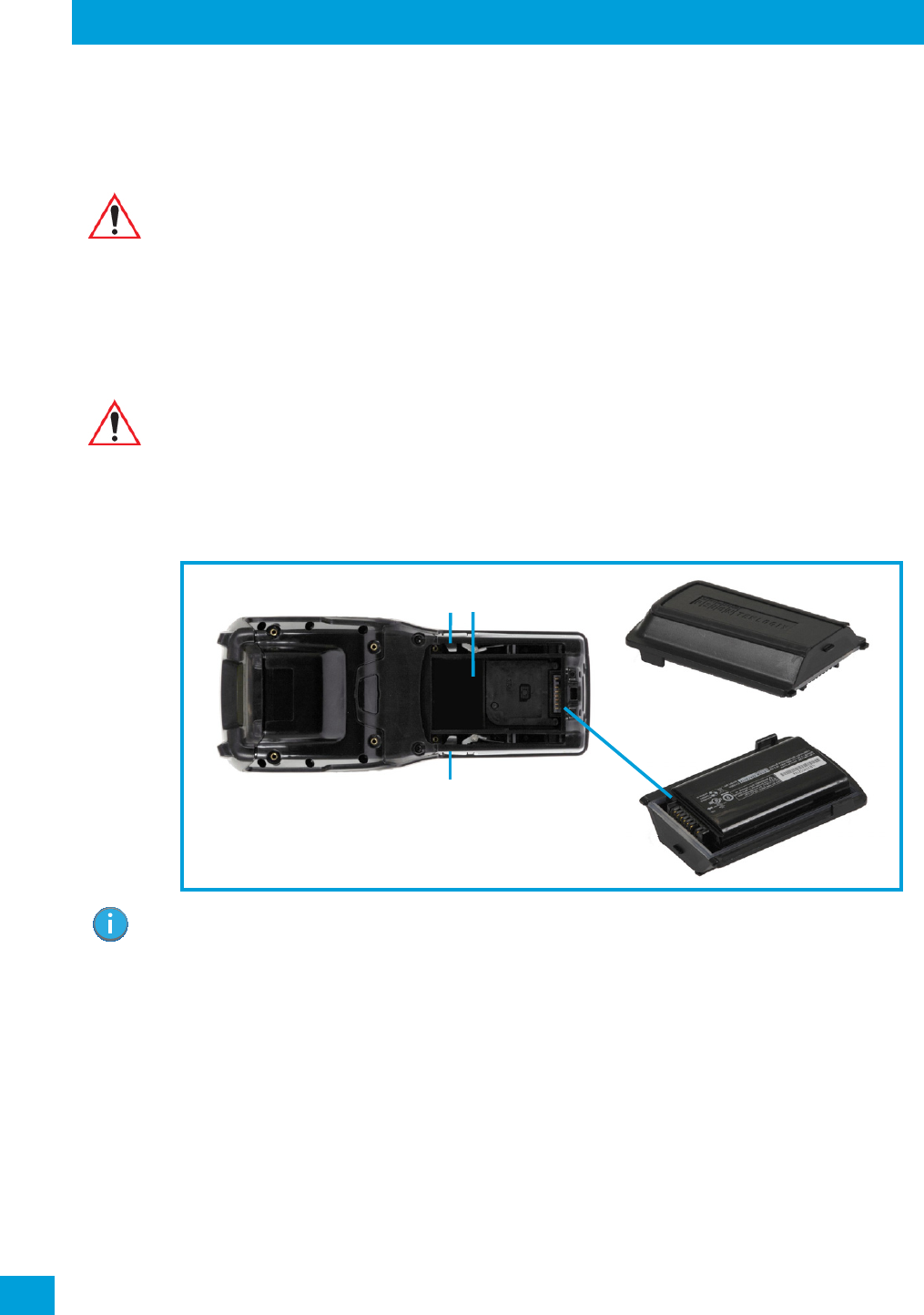
Chapter 2: Basic Operation
Preparing Omnii for Operation
Psion Omnii Hand-Held Computer User Manual
14
2.4 Preparing Omnii for Operation
2.4.1 The Battery
Omnii is powered by a Lithium-ion Smart Battery pack, 5000 mAh—Model ST3000.
Battery packs shipped from the factory are charged to approximately 40% and must be fully charged prior
to use. Batteries can be charged using a variety of chargers and docking stations. For detailed information,
see “Battery Details” on page 21.
Replacing the Battery Pack
Figure 2.6 Omnii Battery
Assuming the default power saving parameters and battery reserve level have not been altered, a battery
can be removed for up to 5 minutes without losing data. After 5 minutes the terminal may reboot.
Removing the Battery Pack
• If your unit is equipped with a hand strap, unhook it from the base of the battery.
• Press the two latch buttons at the sides of the compartment simultaneously, and slide the battery out.
Installing the Battery Pack
• Slide the charged battery with the contoured plastic facing you into the unit with the contacts match-
ing position and the guide tabs moving into the corresponding slots at the base of the compartment.
Click both sides of the battery into place.
• If your computer is equipped with a hand strap, re-attach the clip to the slot at the base of
the battery.
• Switch the unit on (see “Switching Omnii On and Off” on page 15).
Important: Before charging the battery, it is critical that you review the battery safety guide-
lines in the Omnii Hand-Held Computer Regulatory & Warranty Guide
(PN 8000191).
Important: Always switch the unit off before changing the battery (see “Switching Omnii On
and Off” on page 15). However, assuming the default power saving parameters and
battery reserve level have not been altered, battery swap time is a minimum of 5
minutes—you will not lose data if the battery is replaced within this time frame.
2 - Battery Compartment
Contacts
Battery Top
Battery Bottom
1 - Release Latch
3 - Guide Tabs
4 - Latch Tabs
3
3
3
1
12
4
4
Note: If you are using a docking station or an external power supply, you can insert an uncharged
battery and use the device while the battery charges.
Regulatory Draft
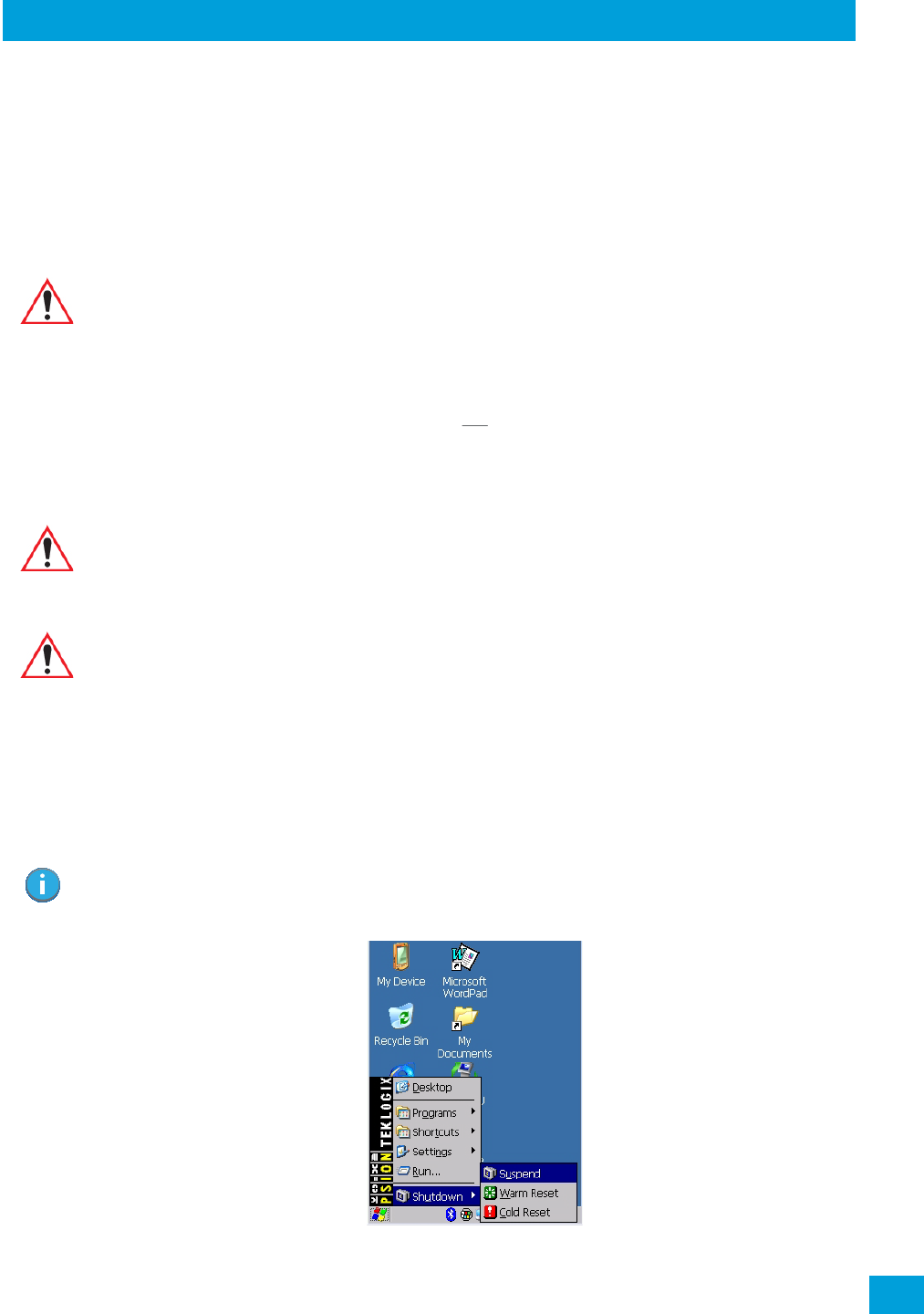
Chapter 2: Basic Operation
Switching Omnii On and Off
15
Psion Omnii Hand-Held Computer User Manual
2.5 Switching Omnii On and Off
Follow the instructions below for your Omnii.
Switching Omnii On
• Press and hold down the [ENTER/Power] key for at least one second.
When the unit is turned off, normally it automatically enters a power-saving, “suspend” state. When Omnii
is switched on from the suspend state, operation resumes within a few seconds in the screen in which you
were working prior to turning the computer off.
Switching Omnii Off
• To switch off Omnii, press the [FN] key and then press and release the [ENTER/Power] button. Omnii
will automatically enter the Suspend state.
2.6 Resetting Omnii
To perform a warm or cold reset, you can access the menu by going to Start>Shutdown. Alternatively you
can use the keyboard shortcuts described below.
Important: If your Omnii fails to power up, consider the following troubleshooting options:
The battery may be overheated (>60C°), a non-Psion battery may be installed, or
the battery may have fallen below the configured Suspend Threshold. See “Sus-
pend Threshold and Estimated Battery Backup” on page 87 for details.
To switch on the hand-held, you will need to replace the overheated battery.
However, if you supply AC power to Omnii with a battery that falls below the con-
figured Suspend Threshold, the unit will switch on.
Important: Turning off the hand-held does not result in a complete shutdown; rather, the unit
enters a power-saving, “suspend” state. When Omnii is turned on from suspend
state, operation resumes within a few seconds.
Important: If the word ‘FN’ is displayed underlined in the taskbar area at the bottom of the
screen, this key is locked “on” and Omnii will not switch off. Press the [FN] key
twice followed by [ENTER/Power] to switch Omnii off.
However, if you’ve set the mode to “Lock” (see “Keyboard One Shot Modes” on
page 75), Omnii can be turned off even when the [FN] key is locked ‘on’.
Note: If your Desktop is switched to the PsionVU Shell (refer to “The PsionVU Desktop Shell” on
page 41), resetting the unit is done solely by use of the keyboard shortcuts.
Regulatory Draft
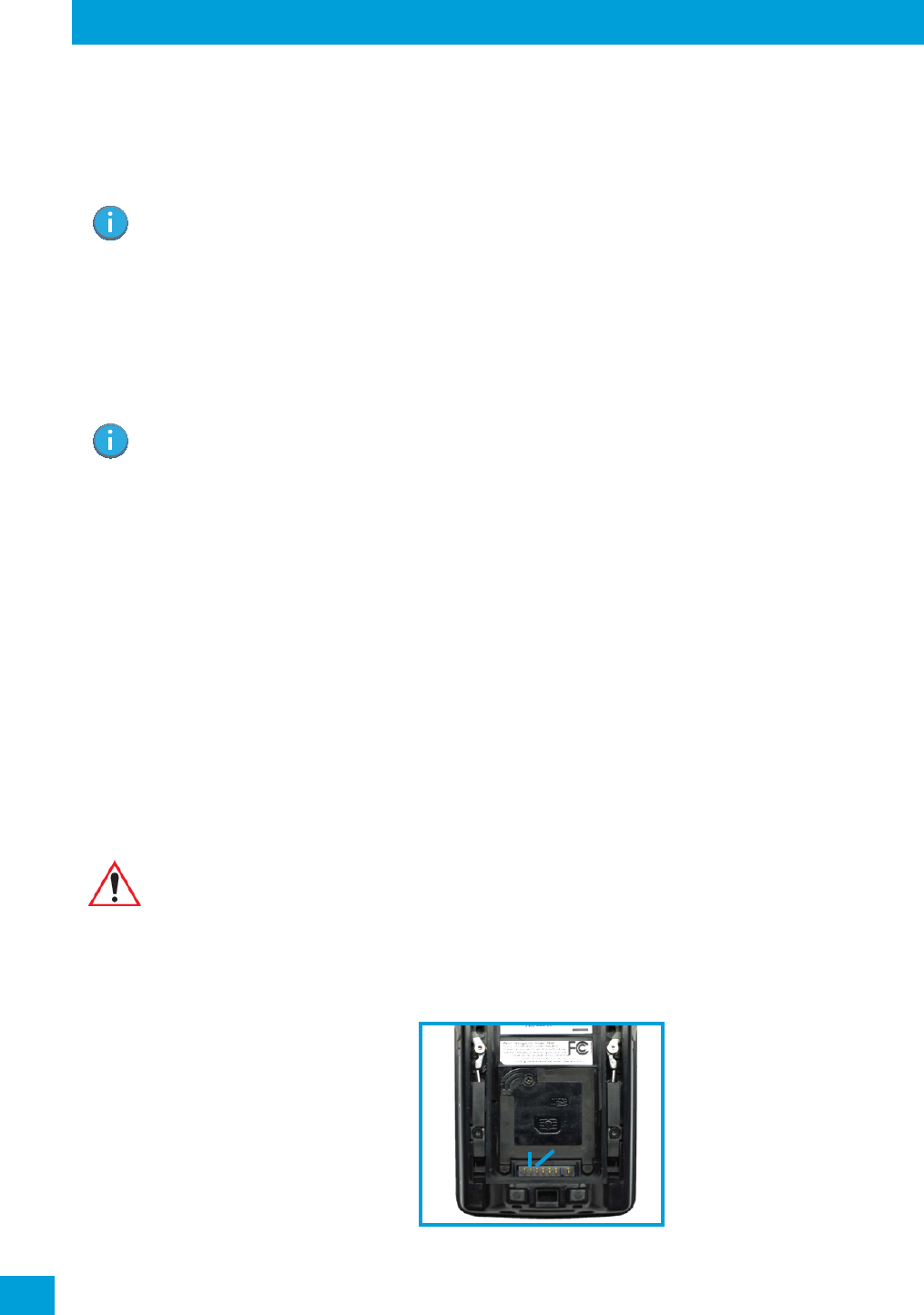
Chapter 2: Basic Operation
Performing a Warm Reset
Psion Omnii Hand-Held Computer User Manual
16
2.6.1 Performing a Warm Reset
During a warm reset, running programs are halted. The contents of the flash memory and the registry are
preserved. Keep in mind, however, that RAM content is not preserved.
• Press and hold down the [FN] key and the [ENTER/Power] key simultaneously for a minimum of
four seconds.
2.6.2 Performing a Cold Reset
A cold reset reinitializes all hardware. All RAM including the RAM disk is erased. Non-volatile storage such
as the Flash disk is preserved.
To execute a cold reset:
• Press and hold down the [SYM] key, the [FN] key, and the [ENTER/Power] key, simultaneously for
a minimum of four seconds.
2.6.3 Performing a Clean Start
A clean start returns Omnii to factory settings, flushes the registry keys and deletes volatile storage.
• Press and hold down the [FN] key, the [ENTER/Power] button and the [SCAN] key simultaneously
for a minimum of six seconds.
Omnii displays the Boot to BooSt menu.
•On an alpha keyboard, type .clean.
•On a numeric keyboard, type .25326.
2.6.4 Boot to BooSt
If you choose Boot to BooSt, the BooSt menu is loaded.
• Press and hold down the [FN] key, the [ENTER/Power] button and the [SCAN] key for a minimum of
four seconds.
•Press [1] to launch the OS.
2.6.5 Performing a Hard Reset
To execute a hard reset:
• Remove the battery.
• Using a coin, or other conductive item, connect pins 5 and 6 of the Omnii battery contacts for at least
6 seconds.
• Replace the battery and power Omnii on. The terminal will boot as if from a cold reset.
Note: You do not need to reset your Omnii after configuring the radio.
Note: As part of the normal Windows Embedded CE cold boot process, the screen may go blank for
a few seconds after the splash screen loading bar reaches the end. The desktop is displayed
after a few moments.
Important: This procedure is recommended as a last resort, when all other methods fail.
Pin 6 Pin 5
Regulatory Draft

Chapter 2: Basic Operation
Attaching Carrying Accessories
17
Psion Omnii Hand-Held Computer User Manual
2.7 Attaching Carrying Accessories
Psion recommends that a carrying accessory — a hand strap — be installed on Omnii before
use. For detailed information, please see “Carrying and Protective Accessories” on page 134.
2.8 Calibrating the Touchscreen
The Omnii touchscreen feature is factory-calibrated and ready-to-go; however, over time the touchscreen's
operating parameters may change, and it may need to be recalibrated for correct operation. Refer to “Cali-
brating the Touchscreen” on page 26 for details.
2.9 Imager and Scanner Options
If your Omnii is equipped with an internal imager or scanner, please review the relevant sections:
Appendix B: “Imager & Camera Settings” and Appendix C: “Scanner Settings” for details.
Appendix D: “Internal Imager & Scanner Specifications” lists their current model numbers, descriptions,
and specifications.
2.10 Connectivity
For information on connecting Omnii to a PC, please refer to “Data Transfer between Omnii and a PC” on
page 64
Omnii contains an integrated 802.11b/g radio module. The Wi-Fi Config application is used to configure the
radio for one or more wireless network profiles. To configure the radio, follow the steps outlined under the
heading “Wi-Fi Config” on page 121.
To confi gu re your Bluetooth settings, please go to “Bluetooth® Setup” on page 54.
If you have a GPS (Global Positioning System) module, you can choose from a set of GPS profiles built into
the modem and set up AGPS (Assisted Global Positioning System). See “GPS (Global Positioning System)
Settings” on page 68.
To see the radio specifications, please go to “Wireless Radios” on page E-6.
2.11 Data Transfer
Data transfer options vary slightly depending on the type of operating system installed in your PC. Various
options exist depending on whether you are using Windows XP or earlier, Windows Vista® , Windows 7 or
later. For connection details, please refer to “Data Transfer between Omnii and a PC” on page 64.
2.12 Voice Communication
If either the MC75i GSM/GPRS/EDGE or the Cinterion PH8 GSM/GPRS/EDGE WWAN radio modem is in-
stalled and enabled, the Phone icon and the GSM signal strength icon will appear automatically on the task-
bar. For details on using your Voice options, please refer to “Voice – Using the Phone Dialer” on page 116.
Note: The touchscreen function can be turned off (see “Touch” on page 110).
Regulatory Draft
Regulatory Draft

19
Psion Omnii Hand-Held Computer User Manual
3GETTING TO KNOW YOUR
OMNII
GE TTING TO K NOW YOUR OMN II 3
3.1 Operating System........................................................ 21
3.2 Battery Details.......................................................... 21
3.2.1 Battery Safety.................................................... 21
3.2.2 Battery Swap Time.................................................. 21
3.2.3 Charging the Battery................................................ 21
3.3 The Keyboard...........................................................22
3.3.1 Regular Keys.....................................................22
3.3.2.1 Activating Modifier Keys.........................................24
3.3.2.2 Locking Modifier Keys..........................................24
3.3.2 Modifier Keys.....................................................23
3.3.3 Function Keys and Macro Keys...........................................25
3.3.3.1 Function Keys...............................................25
3.3.3.2 Macro Keys ................................................25
3.3.4 Numeric Keyboards—Accessing Alpha Keys...................................25
3.3.5 The Keypad Backlight................................................26
3.4 The Display............................................................26
3.4.1 Adjusting the Display Backlight..........................................26
3.4.2 Calibrating the Touchscreen............................................26
3.5 Indicators.............................................................27
3.5.1 LEDs..........................................................27
3.5.1.1 Battery Charge Status LED.......................................28
3.5.1.2 Operating System Status LED .....................................28
3.5.1.3 Radio Status LED.............................................28
3.5.1.4 Scanner Status LED...........................................28
3.5.2 Onscreen Indicators.................................................29
3.5.3 Audio Indicators...................................................30
3.6 Inserting the microSD Card and SIM Card..........................................30
3.6.1 Inserting the Cards .................................................30
3.7 Scanners and Imagers...................................................... 31
3.7.1 Basic Scanner Operations.............................................32
3.7.2 Scanning Techniques................................................32
3.7.3 Scanner Status LED, Sounds, and Vibrations..................................32
3.7.4 Troubleshooting...................................................32
3.7.5 Operating One Dimensional (1D) Internal Laser Scanners...........................33
3.7.6 Operating Internal Two Dimensional (2D) Imagers...............................33
3.8 Windows Embedded CE 6.0 ..................................................33
3.8.1 Navigating in Windows Embedded CE and Applications............................33
3.8.1.1 Navigating Using a Touchscreen....................................34
3.8.1.2 Navigating Using the Keyboard.....................................34
3.8.2 The Windows Classic Shell Startup Desktop...................................34
3.8.2.1 The Taskbar................................................35
3.8.2.2 The Start Menu..............................................36
3.9 The PsionVU Desktop Shell................................................... 41
3.9.1 Restoring the Windows Classic Shell.......................................43
3.10General Maintenance......................................................43
Regulatory Draft

Psion Omnii Hand-Held Computer User Manual
20
3.10.1 Caring for the Touchscreen ............................................43
3.10.2Cleaning Omnii....................................................44
Regulatory Draft

Chapter 3: Getting To Know Your Omnii
Operating System
21
Psion Omnii Hand-Held Computer User Manual
3.1 Operating System
• Microsoft Windows Embedded CE 6.0
3.2 Battery Details
Omnii Hand-Held Computers operate by lithium-ion battery packs, Model ST3000.
Please see the following sections for detailed battery information:
• Installation: “Preparing Omnii for Operation” on page 14.
• Calibration and power settings: “Power Properties” on page 85.
• Chargers and docking stations: Chapter 5: “Accessories”.
• Specifications: “Lithium-ion Smart Battery 5000 mAh (ST3000)” on page E-5.
• Contact pinout: “Omnii Battery Contacts” on page A-6.
3.2.1 Battery Safety
3.2.2 Battery Swap Time
Assuming the default power saving parameters and battery reserve level have not been altered, battery
swap time is a minimum of 5 minutes—you will not lose data if the battery is replaced within this time frame.
To protect data, the safest place to store data is on a microSD memory card or externally to the device on a
USB memory stick or on a PC. You can also save data in the “Flash Disk” partition of the file system.
Refer to “Suspend Threshold and Estimated Battery Backup” on page 87 for details about reserving battery
power for data backup purposes.
The Suspend Threshold adjustment in the Power Properties tab allows you to determine the battery capac-
ity at which Omnii will be shut down. If left at the default value, Maximum Operating Time, the unit will run
until the battery is completely empty; the RAM is only backed up for a short period of time. If you choose
Maximum Backup Time, Omnii shuts off with more energy left in the battery so RAM can be backed up for a
longer period of time.
3.2.3 Charging the Battery
Batteries shipped from the factory are charged to approximately 40% of capacity. Lithium-ion battery
packs must be fully charged before use. These batteries can be charged with a variety of chargers and
docking stations. For detailed information on these accessories, please see Chapter 5: “Accessories”.
Important: Before attempting to install, use, or charge the battery pack, it is critical that you
review and follow the important safety guidelines in the quick reference guide
entitled the Omnii Hand-Held Computer Regulatory & Warranty Guide,
PN 8000191.
Important: If your Omnii fails to power up, consider the following troubleshooting options:
The battery may be overheated (>60C°), a non-Psion battery may be installed, or
the battery may have fallen below the configured Suspend Threshold. See “Sus-
pend Threshold and Estimated Battery Backup” on page 87 for details.
To switch on the hand-held, you will need to replace the overheated battery.
However, if you supply AC power to Omnii with a battery that falls below the con-
figured Suspend Threshold, the unit will switch on.
Regulatory Draft
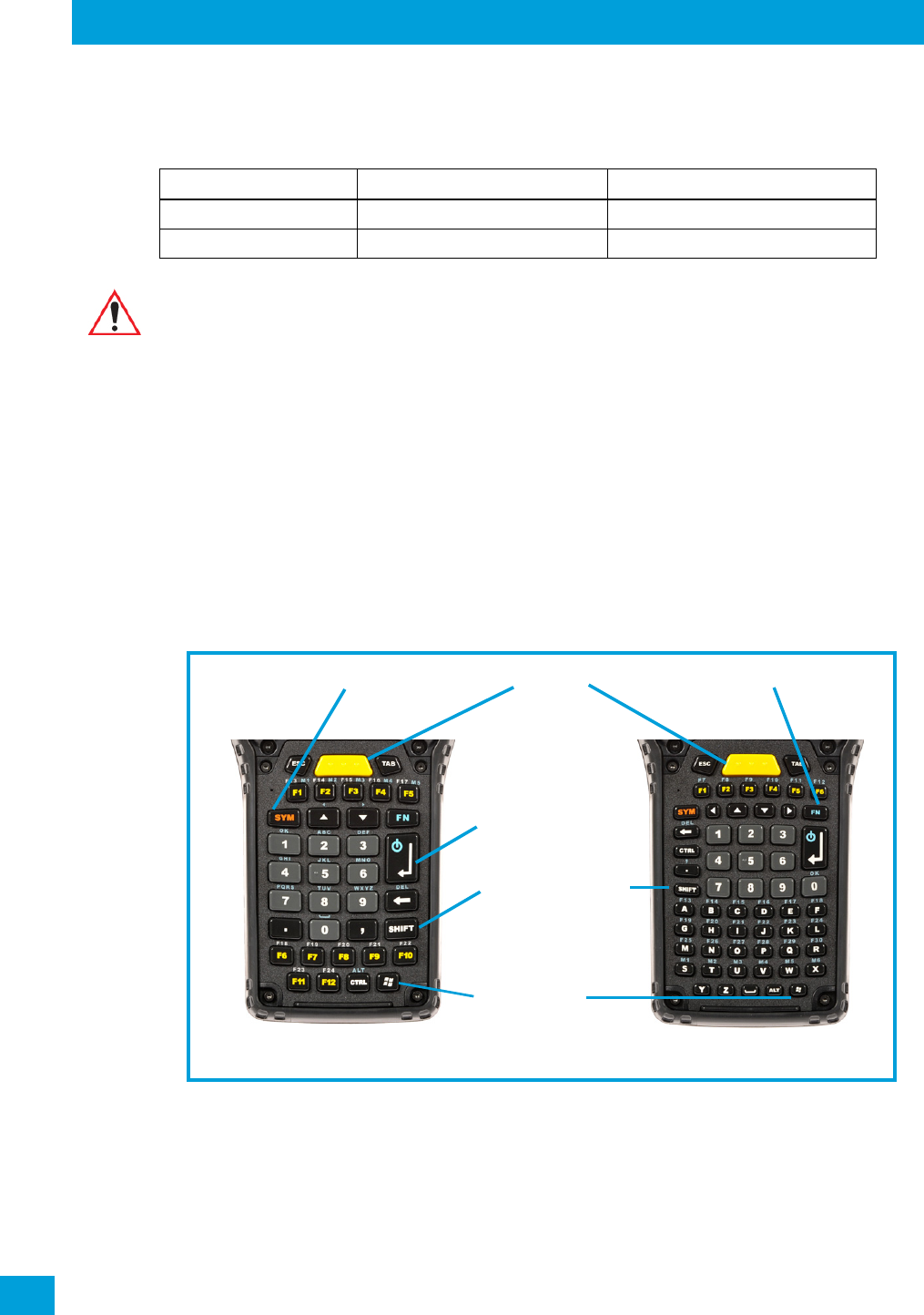
Chapter 3: Getting To Know Your Omnii
The Keyboard
Psion Omnii Hand-Held Computer User Manual
22
Normally it takes 3 to 4 hours to charge a battery. The Omnii intelligent charging system protects the
battery from over-charging by terminating the charge process when the battery is at maximum capacity.
3.3 The Keyboard
Omnii offers a wide variety of Alpha and Numeric keyboard layouts. See http://www.psion.com/us/prod-
ucts/handheld/omniit10_accessories.htm for a list of available configurations. Most of the keys on these
keyboards operate much like a desktop computer. Where a key or key function is not consistent with the PC
keyboard, those differences are described in the following sections.
Omnii is equipped with an [Enter/Power] key that allows you to switch the unit on and to shut down the unit
to Suspend or Standby mode. For details refer to “Switching Omnii On and Off” on page 15.
There are a number of modifier keys that provide access to additional keys and system functions, as de-
scribed in “Modifier Keys” on page 23.
Figure 3.1 Keyboard Layouts
3.3.1 Regular Keys
The [ENTER/Power] Key
The [ENTER/Power] key is used to execute the usual Enter keyboard functions as well as to power the unit
on and off (for details refer to “Switching Omnii On and Off” on page 15).
Table 3.1 Omnii Internal Battery Charging Times
% Charge Completed During Sleep Mode While Operating
100% 4 hrs. 8 hrs.
75% 2 hrs. 6 hrs.
Important: To avoid damaging the battery, chargers will not begin the charge process until
the battery temperature is between 0°C to 45°C (32°F to 113°F).
36-KEY Numeric 123 Keyboard 59-KEY Alpha ABC Keyboard
[FN] Modifier Key
[SYM] Modifier Key
[SHIFT] Modifier Key
[SCAN] Key
[ENTER/Power] Key
[Windows] Key
Regulatory Draft

Chapter 3: Getting To Know Your Omnii
Modifier Keys
23
Psion Omnii Hand-Held Computer User Manual
The [SHIFT] Key
The [SHIFT] key is used to display uppercase alpha characters and to provide access to other symbols and
functions on the numeric keyboards. Press the [SHIFT] key to turn the shift state 'on' (it will be represented
by an up arrow in the taskbar), then press another key to access the shifted function of that key.
Press the [SHIFT] key twice to lock the shift state on (the up arrow in the taskbar will be underlined). Press
[SHIFT] again to turn the shift state off.
To access CAPS LOCK mode, press [FN] + [SHIFT]. In this state, if you press a numeric key, the number is
displayed rather than the normal shifted function of that key. Press [FN] + [SHIFT] again to turn the CAPS
LOCK mode off.
The Arrow Keys
The [Arrow] keys are located near the top of the keyboard, and are represented on the keyboard as trian-
gles pointing in different directions. The [Arrow] keys move the cursor around the screen in the direction of
the arrow: up, down, left and right. The left arrow key should not be confused with the [BACKSPACE] key
which is depicted as a left arrow. The cursor is the flashing box or underline character that indicates where
the next character you type will appear.
The [BACKSPACE/DEL] Key
The [BACKSPACE] key (represented on the keyboard as an arrow pointing left) moves the cursor one char-
acter to the left, erasing the previous key stroke.
The [DEL] key ([FN] +[BACKSPACE]) erases the character at the current cursor position.
The [CTRL] and [ALT] Key
The [CTRL] and [ALT] keys modify the function of the next key pressed and are application dependent.
Pressing either key twice locks it 'on' (it appears underlined on the Taskbar). Pressing the key once again
unlocks it.
The [TAB] Key
Typically, the [TAB] key moves the cursor to the next field to the right or downward.
The [ESC] Key
Generally, this key is used as a keyboard shortcut to close the current menu, dialog box, or activity.
The [SPACE] Key
The [SPACE] key is represented on the keyboard by a long, low horizontal line contained by a small vertical
line on each side. Pressing this key inserts a blank space between characters. In a Windows dialog box,
pressing the [SPACE] key enables or disables a checkbox.
The [SCAN] Key
Omnii is equipped with a single [SCAN] key on the keyboard and an extra [SCAN] button located on the left
side of the unit. [SCAN] keys activate the scanner beam. For units that do not have internal scanners, these
keys can be remapped to serve other functions.
3.3.2 Modifier Keys
The [SHIFT], [CTRL], [ALT], [FN] and [SYM] keys are modifier keys that change the function of the next key
pressed.
The [SHIFT], [CTRL] and [ALT] keys operate much like a desktop keyboard except that they are not chorded
(two keys held down simultaneously). The modifier key must be pressed first followed by the key whose
function you want modified.
[SHIFT] and [FN]
The [SHIFT] and [FN] modifier keys provide access to additional keys and system functions. The functions
related to these modifier keys are colour-coded in white and blue print respectively above the keyboard
keys, dependant on your keyboard format.
Regulatory Draft
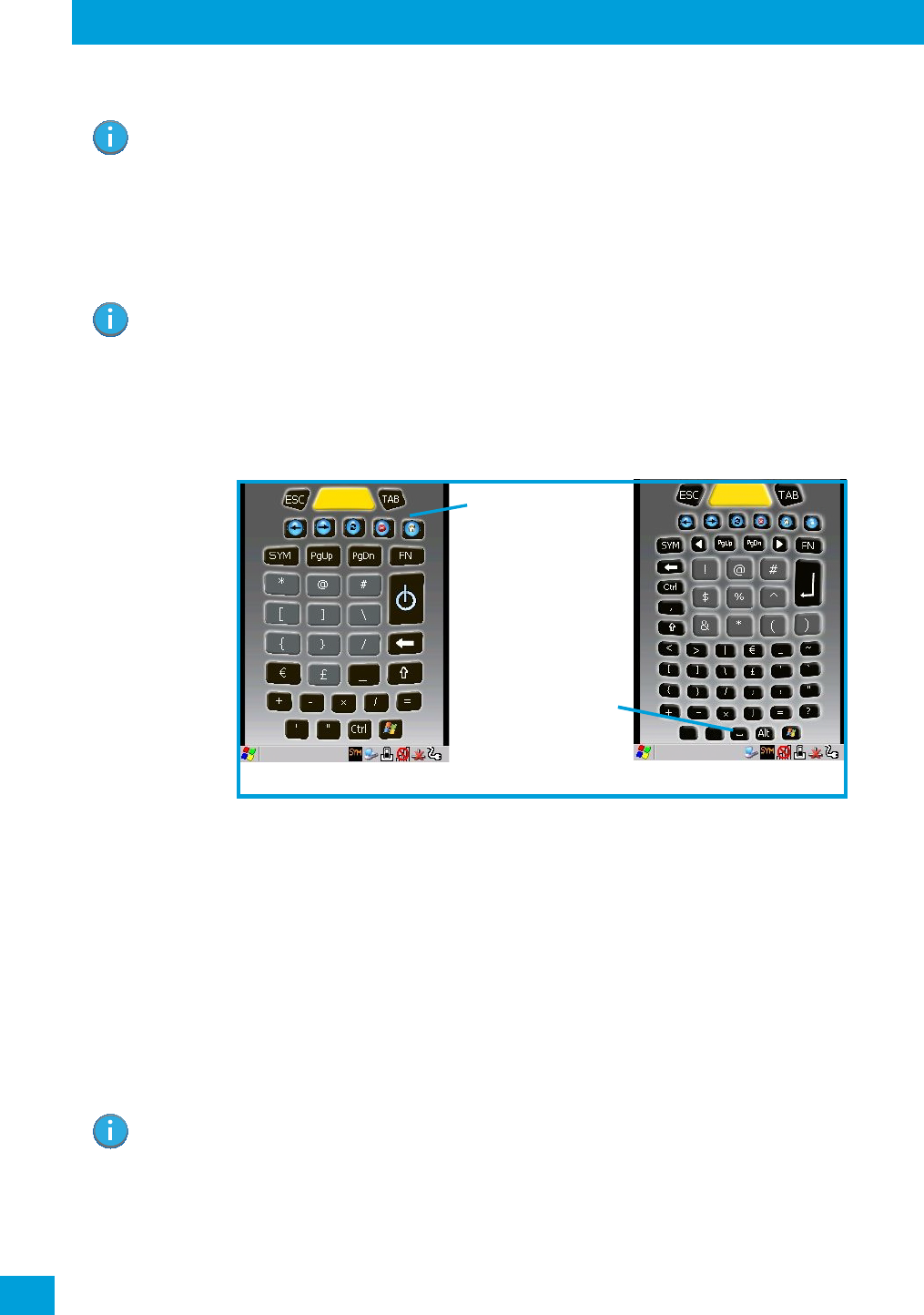
Chapter 3: Getting To Know Your Omnii
Modifier Keys
Psion Omnii Hand-Held Computer User Manual
24
[SYM]
The Symbol [SYM] modifier key is represented on the keyboard by the characters ‘SYM’ and provides
access to commonly used symbolic characters. Pressing the key brings up the Symbol soft input panel (SIP)
onscreen keyboard, with symbols mapped to each key. If you wish to adjust the settings for the pop-up
screen (e.g. time of delay before screen appears, etc.), modify the file softinputpanel.xml, located in the
Windows folder.
The onscreen keyboard corresponds to the specific keyboard on your Omnii—either numeric or alphanu-
meric.
Figure 3.2 Symbol Soft Input Panels
3.3.2.1 Activating Modifier Keys
When a modifier key is pressed, it is shown in the softkey bar at the bottom of the screen, making it easier
to determine whether a modifier key is active. For example, if the [CTRL] key is pressed, Ctrl is displayed at
the bottom of the unit screen. Once the next key is pressed, the modifier key becomes inactive and disap-
pears from the taskbar.
3.3.2.2 Locking Modifier Keys
When a modifier key is pressed twice, it is ‘locked’ on. A ‘locked’ modifier key is displayed in underlined
letters in the taskbar. For example, pressing the [FN] key twice locks it on—it is displayed as an underlined
blue ‘FN’ in the taskbar at the bottom of the computer screen. The same is true of the [SYM] key, which is
shown as an underlined orange ‘SYM’ in the taskbar.
The locked modifier key will remain active until it is pressed a third time to unlock or turn it off. Once a mod-
ifier key is unlocked, the underline representation at the bottom of the screen is no longer displayed.
Note: When using the Mobile Devices SDK Developers' Guide (P/N 8100016), note that the [SYM]
key is interchangeable with the [ORANGE] key.
Note: Modifier keys are remapped in the Control Panel, and the Symbol SIP will automatically show
and use the new mappings after the next reboot.
36-KEY Numeric Keyboard 59-KEY Alpha Keyboard
[SPACE] Key
Internet Browser Keys
Note: The locking function of the modifier keys can be changed so that pressing a key once will
lock the key ‘on’.
If you disable the ‘One Shot’ function of the key, pressing it once will lock the key ‘on’. Press-
ing the same key a second time will unlock or turn it ‘off’. Refer to “Keyboard One Shot
Modes” on page 75 for details.
Regulatory Draft

Chapter 3: Getting To Know Your Omnii
Function Keys and Macro Keys
25
Psion Omnii Hand-Held Computer User Manual
3.3.3 Function Keys and Macro Keys
In addition to the standard keyboard functions (see “The Keyboard” on page 22), Omnii supports function
keys and macro keys.
All function keys and macro keys can be custom defined for each application. The Open TekTerm applica-
tion utilizes these keys (for detailed information, see the Open TekTerm Software User Manual,
P/N 8000073).
3.3.3.1 Function Keys
Function keys perform special, custom-defined functions within an application. These keys are accessed by
pressing one of the dedicated function keys on the keyboard, or through the appropriate [SHIFT] or [FN]
key sequence, depending on the keyboard variant being used.
Alphanumeric Keyboard Function Keys
The Alphanumeric keyboards are equipped with up to thirty function keys, including those function keys
that are colour-coded in blue print above the alpha keys or function keys (depending on your keyboard).
To access the blue function keys, press the [FN] key followed by the appropriate alpha or function key.
Function keys [F1] through [F24] can be used with the Windows Embedded CE operating system or another
application. The additional function keys, [F25] through [F30] along with the macros, are not used as part
of the Windows Embedded CE operating system.
Numeric Keyboard Function Keys
The Numeric keyboards are equipped with up to 24 function keys, including those function keys that are
colour-coded in white print above the function keys. Function keys F25 through F30 can only be accessed
by remapping another key to that function.
To access the white function keys, press the [SHIFT] key followed by the appropriate function key.
3.3.3.2 Macro Keys
Several of the Omnii keyboards are equipped with a series of macro keys that can be programmed to
replace frequently used keystrokes, along with the function of executable keys like the [ENTER/Power] key,
the [BACKSPACE] key, any function key and arrow key, etc.
59-Key Alphanumeric Keyboard Macro Keys
These keyboards have six macro keys: [M1] to [M6], located on the S to X keys (second-last row of keys).
To access a macro key, press the [FN] key followed by the macro key.
36-Key Numeric Keyboard Macro Keys
These keyboards are equipped with five macro keys: [M1] to [M5]. These keys are colour coded in blue print
above function keys [F1] to [F5].
To access a macro key, press the [FN] key followed by the macro key.
3.3.4 Numeric Keyboards—Accessing Alpha Keys
On the Numeric Omnii keyboards, all alphabetic characters are printed on the unit plastic in blue typeface
above the keys. Alpha characters are accessed by pressing the [FN] modifier key, then pressing another key
on the keyboard.
The Alpha Modified Numeric 789 keyboard has each blue alphabetic character assigned as a single [FN]-
shifted character on individual keys. An indicator in the left corner of the taskbar displays the currently se-
lected character.
The Numeric 123 keyboards have telephone-style alphabetic keys, with the blue alphabetic characters
located in groups of 3 or 4 above each of the numeric keys. To access characters on these keyboards, a few
extra steps are needed, as described below.
Important: Refer to “Keyboard Macro Keys” on page 75 for details about creating macros.
Regulatory Draft

Chapter 3: Getting To Know Your Omnii
The Keypad Backlight
Psion Omnii Hand-Held Computer User Manual
26
Choosing a Single Alpha Character
The examples below illustrate how to access A, B and C, all of which are printed in blue characters above
the numeric key [2]. The letters you choose appear in the softkey bar as you press the numeric key, provid-
ing a visual indicator of which letter will be displayed on the screen.
To choose the letter ‘a’:
• Press the [FN] key, and press the numeric key [2].
• Press the [FN] key again to unlock or turn it off.
To choose the letter ‘b’:
• Press the [FN] key, and press [2] twice.
• Press the [FN] key again to unlock or turn it off.
To choose the letter ‘c’:
• Press the [FN] key, and press [2] three times.
• Press the [FN] key again to unlock or turn it off.
Selecting Uppercase Letters
To display a single capital letter, press the [SHIFT] key first, then the letter you want.
To access CAPS LOCK mode, press [FN] + [SHIFT]. In this state, if you press a numeric key, the number is
displayed rather than the normal shifted function of that key. Press [FN] + [SHIFT] again to turn the CAPS
LOCK mode off.
3.3.5 The Keypad Backlight
The intensity of the keypad backlight and the conditions under which this backlight is activated can be con-
figured using the Keyboard icon in the Windows Embedded CE Control Panel. The behaviour of the keypad
backlight is tailored in the Keyboard Properties dialog box. Refer to “Keyboard Backlight” on page 74 for
details about this option.
3.4 The Display
Omnii is equipped with display backlighting to improve character visibility in low light conditions. The back-
light switches on when a key is pressed.
3.4.1 Adjusting the Display Backlight
The behaviour of the display backlight and the intensity of the backlight can be specified in the Display
Properties dialog box in the Control Panel.
3.4.2 Calibrating the Touchscreen
If your Omnii touchscreen has never been calibrated, or if you find that the stylus pointer is not accurate
when you tap on an item, use the Stylus Properties dialog box in the Control Panel to recalibrate the screen.
•In the Control Panel, choose the Stylus icon to display the Stylus Properties window.
Note: The following examples assume that the [FN] key is enabled as ‘Lock’ mode in the ‘One Shot’
screen (accessible through the Control Panel Keyboard icon). In ‘Lock’ mode, pressing the
[FN] key once locks it ‘on’. Refer to “Keyboard One Shot Modes” on page 75 for details.
Note: Keep in mind that there is a timeout of one second between key presses when sequencing
through the alphabetic characters on a key. If you pause longer than one second between
key presses, the alphabetic character that is displayed at that time will be entered.
Note: Keep in mind that this option may be restricted to supervisory use only.
Note: Refer to “Backlight” on page 66 for details about the Display Properties dialog box.
Regulatory Draft
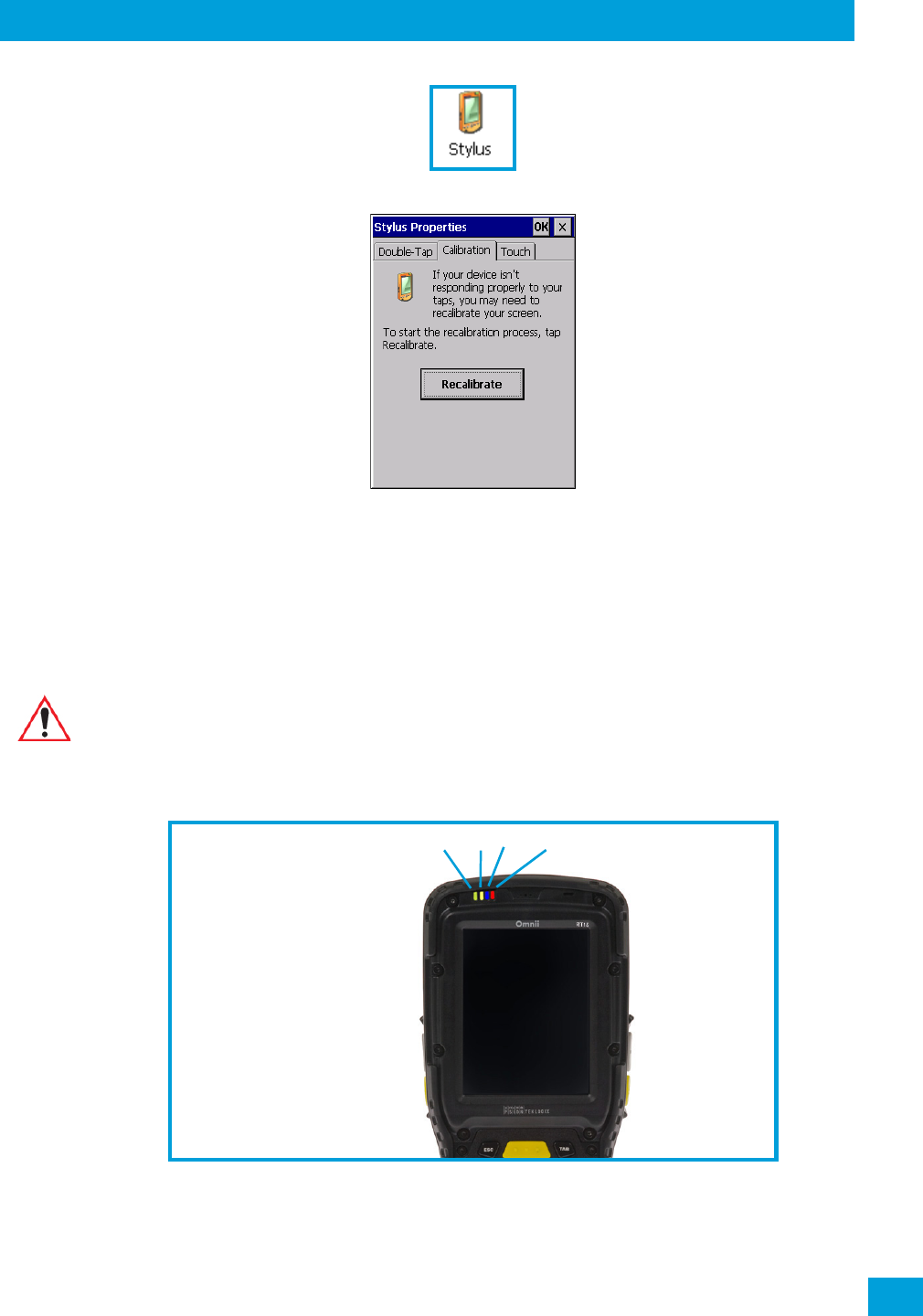
Chapter 3: Getting To Know Your Omnii
Indicators
27
Psion Omnii Hand-Held Computer User Manual
• Select the Calibration tab, and then choose the Recalibrate button.
• Follow the directions on the calibration screen to calibrate the screen.
3.5 Indicators
Omnii uses LEDs (Light Emitting Diodes), onscreen messages, vibrations, and audio tones as indicators.
3.5.1 LEDs
Omnii is equipped with four coloured LEDs. This section outlines what these LEDs indicate.
Figure 3.3 LED Status Indicators
Important: If an LED is illuminated in red, the operator should be cautious as this generally
indicates an abnormal operating condition or active laser emission.
3. GPS Status
4. Scanner Status
1. Battery Charge Status
2. Operating System Status
1234
Regulatory Draft

Chapter 3: Getting To Know Your Omnii
LEDs
Psion Omnii Hand-Held Computer User Manual
28
3.5.1.1 Battery Charge Status LED
The far left LED is reserved for battery charge status. This indicator is active even when the hand-held is in-
serted in a docking station (and in suspend mode) so that the charge status of the battery can be detected
easily.
3.5.1.2 Operating System Status LED
The second LED indicates system notifications and operating system status. It is also available for user-
loaded custom Windows Embedded CE applications.
3.5.1.3 Radio Status LED
The third LED from the left indicates the status of the GPS radio in Omnii.
3.5.1.4 Scanner Status LED
The fourth (far right) LED indicates scanner status.
Table 3.2 Battery Charge LED Behaviours
Charge LED Behaviour Function
OFF External power not detected.
Solid Green Battery charging complete.
Flashing Green Charge in progress.
Yellow Cell temperature out of range for charge.
Solid Red Unable to charge battery.
Table 3. 3
Operating LED Behaviour Function
OFF when unit is in Suspend or Shutdown. Normal operating status.
Solid Yellow The unit is powering on.
Fast Flashing Yellow The unit is in Standby mode.
Flashing Yellow This LED is controlled by the Sounds and
Notifications Control Panel applet.
Table 3.4
Radio Traffic LED Behaviour Function
OFF The GPS radio is disabled.
Slow Flashing Blue The GPS radio is enabled and active.
Table 3.5
Scan LED Behaviour Function
OFF The scanner is not in use.
Solid Red during scan Scan in progress.
Solid Green after decode
OFF when scan ended
Successful scan.
Flashing Red Unsuccessful scan.
Regulatory Draft
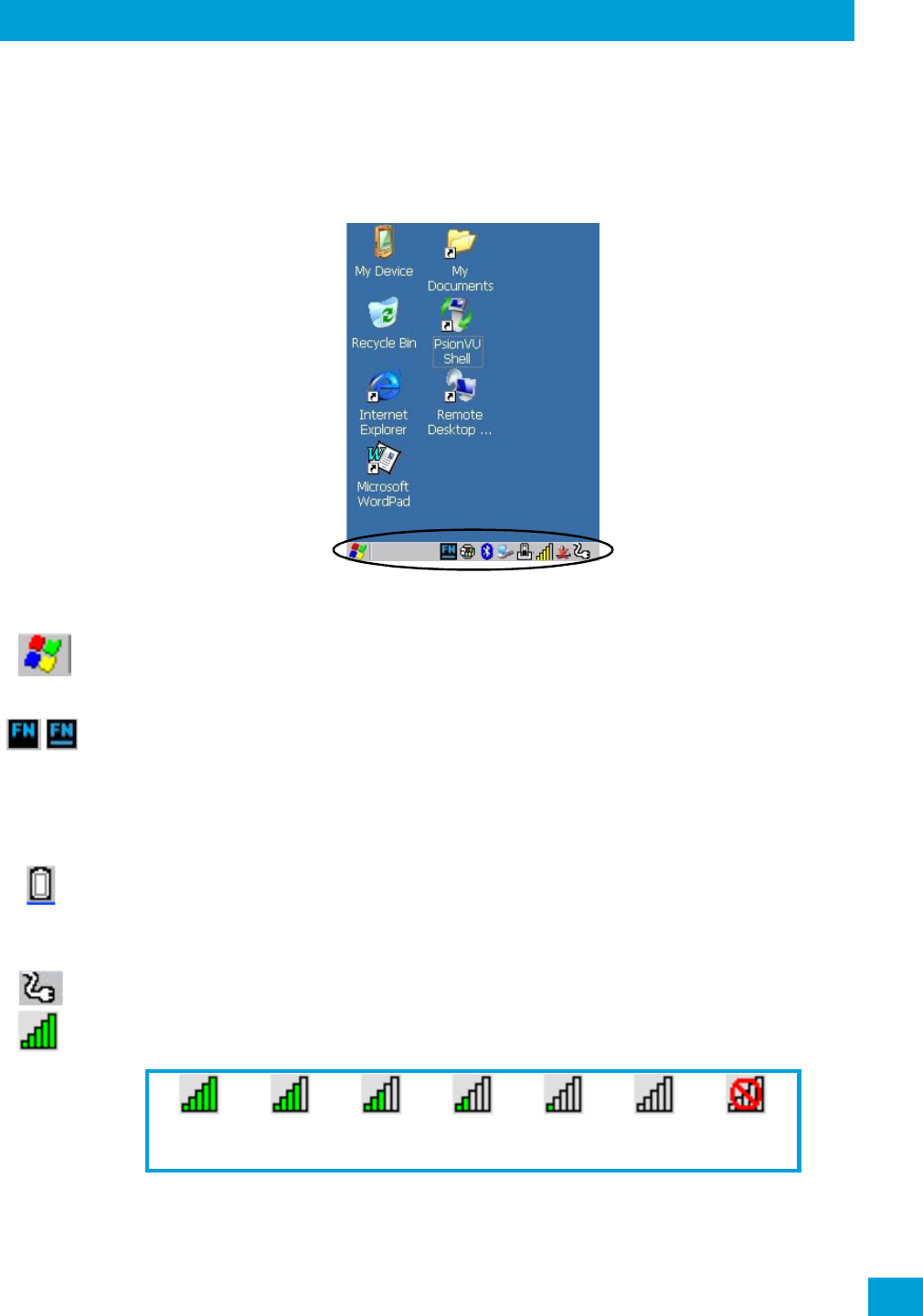
Chapter 3: Getting To Know Your Omnii
Onscreen Indicators
29
Psion Omnii Hand-Held Computer User Manual
3.5.2 Onscreen Indicators
The taskbar at the bottom of the screen displays a variety of system status indicators, including the Input
Panel button if you have chosen to show that option in the Ta s kba r an d Sta r t Menu settings.
Figure 3.4 Taskbar
The taskbar changes dynamically, and only those icons that are applicable are displayed. For example, if a
radio is not installed in your Omnii, the radio signal icon is not displayed in the taskbar.
Windows® Start Button
If you are using the touchscreen, you can either tap the Windows icon at the bottom left of the screen, or
press the [Windows] key to display the Start Menu, and then tap on the desired application.
Modifier Key Indicators
[SHIFT], [CTRL], [ALT], [FN] and [SYM] are modifier keys that have onscreen indicators to show when a key
is active or locked. If a modifier key is pressed once to activate it, the key is displayed in the taskbar, for ex-
ample, pressing the [FN] key once displays ‘FN’ in the taskbar. If a modifier key is pressed twice, it is ‘locked
on’ and the onscreen indicator is displayed with underlined letters in the taskbar, for example, pressing [FN]
twice displays ‘FN’ in the taskbar.
Power
The battery shaped icon displayed in the taskbar provides quick access to the charge state of the battery.
Tapping on the icon once will show the percentage charge left in the battery. Tapping on the icon twice
opens the Power Properties menus (see “Power Properties” on page 85), where you can set the low battery
warnings levels, and time to enter Suspend.
If Omnii is using external AC power, an AC icon is displayed in the taskbar.
802.11 Radio Signal Quality
Increasing radio signal quality is represented by longer, filled bars within this icon.
Good No Radio
Reception
Weak
Reception Link
Regulatory Draft
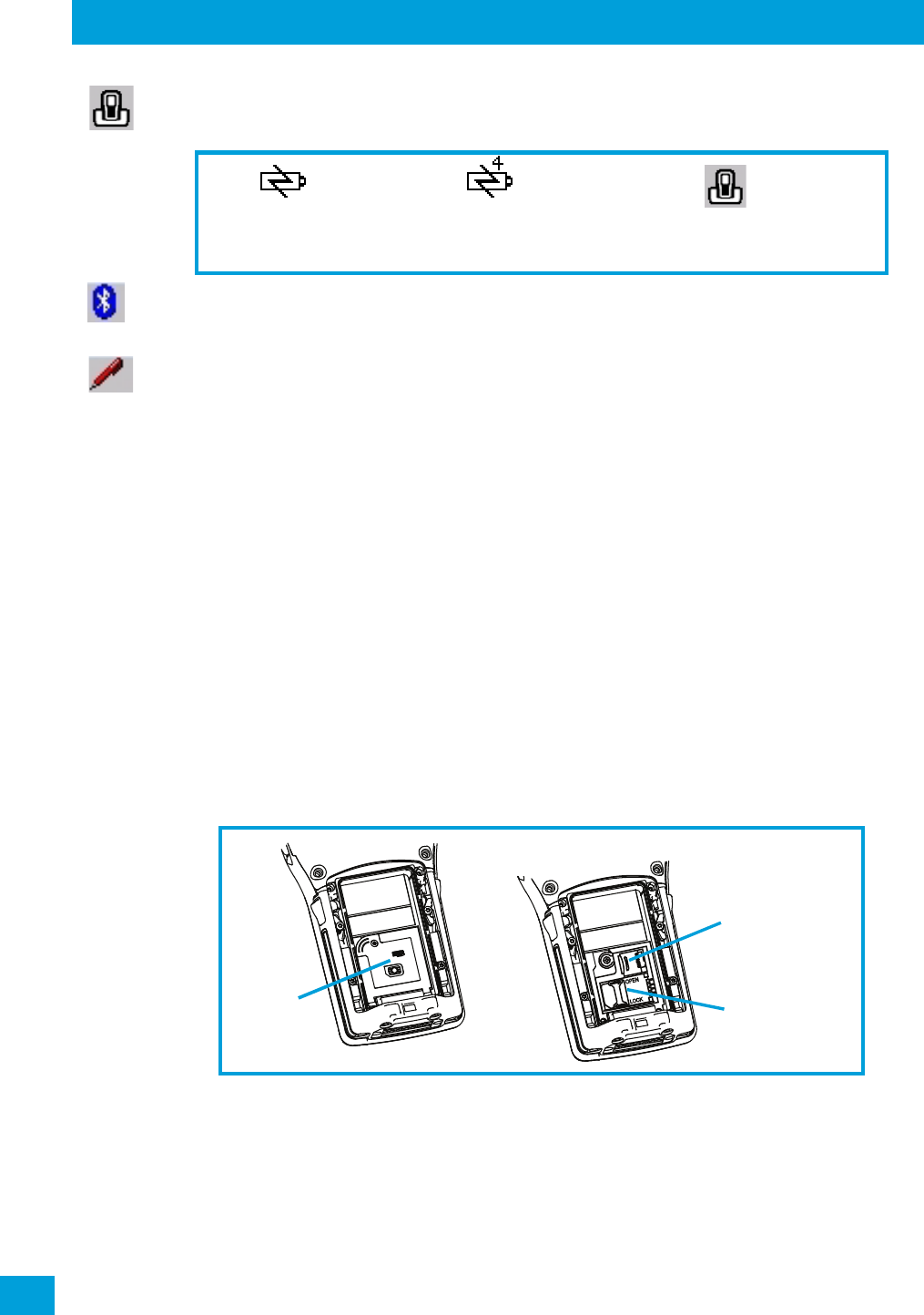
Chapter 3: Getting To Know Your Omnii
Audio Indicators
Psion Omnii Hand-Held Computer User Manual
30
Docking Device
When a hand-held is inserted in a docking station, charger or cradle, an associated icon appears in
the taskbar.
Bluetooth Radio
This icon displayed in the taskbar represents the installed Bluetooth radio.
Input Panel
You can tap the Input Panel icon to activate the soft keyboard application.
3.5.3 Audio Indicators
Omnii supports several audio options, including Bluetooth. The optional rear speaker can be used for
system (Windows) sounds and .wav files. When a rear speaker is absent, those sounds are routed to the
front receiver. The beeper provides a variety of sounds and can be configured to emit a sound when a key is
pressed, a keyboard character is rejected, scan input is accepted or rejected, an operator’s entry does not
match in a match field or the battery is low. The volume rocker button is located on the left side of the
hand-held. Information on configuring sounds is detailed in “Volume & Sounds Properties” on page 120.
3.5.4 Vibrations
You can set Omnii to vibrate when a successful or unsuccessful barcode scan is performed. See “Scanners”,
page 98.
3.6 Inserting the microSD Card and SIM Card
There are two slots available in the battery compartment—the lower slot is provided for a microSD (Secure
Digital) card, which provides additional non-volatile memory to your Omnii, and the upper slot is for a SIM
(Subscriber Identity Module) card, which allows access to the Voice option, access to the Internet, and so
on.
3.6.1 Inserting the Cards
• Switch off the power to Omnii.
• Remove the battery.
• Use a Phillips screwdriver to remove the SD cover screw. Flip the cover open or remove it.
For a microSD card:
• Slide the microSD card door to the left to unlock it. Flip it open.
Combo Charger &
Combo Docking Station
Quad Docking Station Powered Vehicle Cradle, Desktop Dock
& Snap Module
OPEN
LOCK
SD Cover
microSD Card Slot
SIM Card Slot
Regulatory Draft
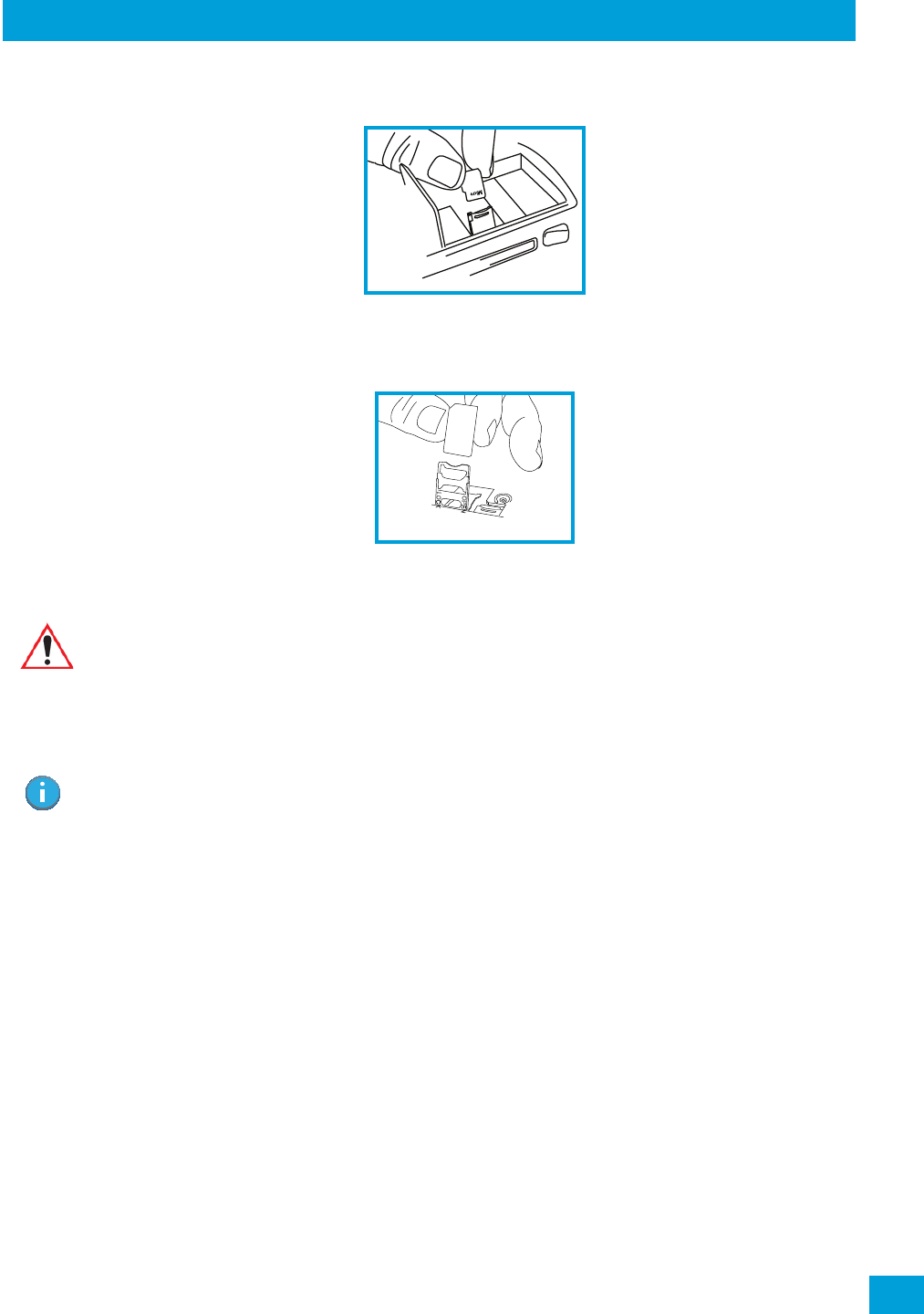
Chapter 3: Getting To Know Your Omnii
Scanners and Imagers
31
Psion Omnii Hand-Held Computer User Manual
• Slide the microSD card into the guides on the SD card door.
• Close the microSD card door, and slide it to the right to lock it.
For a SIM card:
• Slide the SIM card metal door latch to the right to unlock it, then flip the door open.
• Slide the card into the guides on the SIM card door.
• Swing the hinged door back down into place, and slide the metal door latch to the left to lock it.
3.7 Scanners and Imagers
Omnii supports a wide range of scanner options to address a variety of user application requirements.
Refer to the following sections for detailed information:
• Scanner list and specifications: Appendix D: “Internal Imager & Scanner Specifications” .
• Configuration: “Scanners” on page 98 and “Manage Triggers” on page 81.
• “Scanning Techniques” on page 32 outlines the mechanics of a successful scan.
• “Scanner Status LED, Sounds, and Vibrations” on page 32 details how to interpret whether or not a
barcode has been successfully scanned.
• Barcode Parameters: Appendix C: “Scanner Settings”.
• Imager Settings: Appendix B: “Imager & Camera Settings”.
• “Troubleshooting” on page 32 provides some helpful suggestions should the scan fail.
Scanner types include:
• Long Range: reads large 1D barcodes (55 mil) at long distances (up to 3m).
• Standard Range/High Performance: reads damaged or low contrast regular 1D barcodes (5 - 55mil) at
medium distances (up to 1m).
• Extended Range: reads regular 1D barcodes (5 - 55mil) at short to medium distances (1m), as well as
large 1D barcodes (e.g. 55 mil) at long distances.
• Fuzzy Logic: reads damaged or low contrast regular 1D barcodes (5 - 55mil) at medium distances (up to
1m).
icro
M
OPEN
LOCK
Important: It is critical that you review the “Laser Warnings” in the Omnii Hand-Held Compu-
ter Regulatory & Warranty Guide (PN 8000191) before using any of the scanners
described in this chapter.
For detailed scanner specifications and decode zone tables, refer to Appendix D:
“Internal Imager & Scanner Specifications” .
Note: To enable a newly-installed imager or scanner, press and hold down the [FN] key and the
[ENTER/Power] key simultaneously for a minimum of three seconds.
Regulatory Draft

Chapter 3: Getting To Know Your Omnii
Basic Scanner Operations
Psion Omnii Hand-Held Computer User Manual
32
• PDF Raster Laser: reads 2D PDF barcodes or damaged or low contrast regular 1D barcodes (5 - 55mil)
at medium distances (up to 1m).
• 1D Imager: reads regular 1D and PDF417 barcodes at short to medium distances.
3.7.1 Basic Scanner Operations
• Turn the hand-held on. Wait until the unit has booted up completely.
• Aim at the barcode and press the scan key or the trigger. A scan beam and a warning indicator appear
until a successful decode is achieved or six seconds have elapsed.
3.7.2 Scanning Techniques
• Hold the scanner at an angle. Do not hold it perpendicular to the barcode.
• Do not hold the scanner directly over the barcode. In this position, light can reflect back into the scan-
ner’s exit window and prevent a successful decode.
• Scan the entire barcode. If you are using a 1D or PDF laser scanner, make certain that the scan beam
crosses every bar and space on the barcode, including the margins on either end of the symbol.
• If you are using a 2D imaging scanner, make certain the red, oval shaped framing mark is centered
within the barcode you want to scan.
• When using imaging scanners, do not move the scanner while decoding the barcode. Movement blurs
the image.
• Hold the scanner farther away for larger barcodes.
• Hold the scanner closer for barcodes with bars that are close together.
3.7.3 Scanner Status LED, Sounds, and Vibrations
The scanner LED (the far right LED) indicates whether or not your scan is successful. The LED behaves as
follows:
• Scan In Progress: scan LED displays solid red colour.
• Successful Scan: scan LED displays solid green colour and turns off when the scan is ended.
• Unsuccessful scan: scan LED flashes red.
A barcode icon appears on the screen during a scan. While the scanner beam is active, the onscreen
message states: SCANNING. If you want to turn off the onscreen message, disable the “Scan Indicator” pa-
rameter in the Control Panel>Scanners>Options>Display menu.
When the scan is successful, the barcode data is displayed on the screen until the scan button (or pistol trig-
ger) is released, but only if the “Scan Result” parameter is turned on in the Control Panel>Scanners>Op-
tions>Display menu.
You can also enable sounds and vibrations to indicate good and bad scans by enabling those options in the
Control Panel>Scanners>Options>Display menu.
3.7.4 Troubleshooting
If the scanner is not working, investigate the following:
• Is the unit on?
• Check that the barcode symbology being scanned is enabled for the hand-held you are using. Check
any other parameters that affect the scanning procedure or the barcode.
• Check the barcode to make sure it is not damaged. Try scanning a different barcode to verify that the
problem is not with the barcode.
• Check that the barcode is within the proper range.
• Does the hand-held display the warning without scanning? This suggests a hardware problem in the
hand-held.
• Is the laser beam scanning across the barcode?
• Once the scan beam has stopped, check the scanner window for dirt or fogging.
Regulatory Draft

Chapter 3: Getting To Know Your Omnii
Operating One Dimensional (1D) Internal Laser Scanners
33
Psion Omnii Hand-Held Computer User Manual
3.7.5 Operating One Dimensional (1D) Internal Laser Scanners
• Turn the hand-held on. Wait until the unit has booted up completely.
• Aim at the barcode and press the scan key or the trigger. A scan beam and a warning indicator appear
until a successful decode is achieved or six seconds have elapsed.
3.7.6 Operating Internal Two Dimensional (2D) Imagers
An imager scanner takes a snap shot of a single barcode or multiple barcodes (at one time). It can find a
barcode regardless of its orientation—that is, even a barcode printed at a 45 degree angle to the hand-held
will be decoded successfully.
Because imager scanners generally have a shorter depth of field than laser scanners, some practise may be
required to find the optimal distance from the types of barcodes being scanned. Although the imager in-
cludes illumination LEDs, ambient light will help the imager decode the barcodes, especially if the barcode
is far from the hand-held.
• Turn the hand-held computer on. Wait until the unit has booted up completely.
• Aim at the barcode and press the scan key or the trigger. Hold the trigger until a successful or failed
scan result is obtained.
• When the scan button or trigger is pressed, a red, oval shaped light (the framing marker) is displayed.
Centre the framing marker in the field—either in the centre of the barcode you want to scan or in the
centre of the area in which multiple barcodes are to be scanned.
The illumination LEDs will flash (typically several times) and a picture of the barcode is taken.
3.8 Windows Embedded CE 6.0
3.8.1 Navigating in Windows Embedded CE and Applications
Graphic user interfaces like Windows Embedded CE for portable devices and desktop Windows (2000, XP,
etc.) utilize ‘point and click’ navigation. An equivalent keyboard shortcut is also available for every ‘point
and click’ action.
Windows Embedded CE supports the same ‘point and click’ user interface and keyboard shortcuts as
desktop Windows with one difference—the ‘point and click’ action is accomplished using a touchscreen
rather than a mouse. Actions can be performed using any combination of keyboard shortcuts or touch-
Important: If an aiming dot is available on the installed scanner, the dot will be enabled for a
configurable time period (including off), after which normal scanning begins. Refer
to “Dot Time (msec)” on page -5 for details.
Double-clicking the trigger will override the aiming delay and initiate an immedi-
ate scan. Note that the aiming dot is standard on long-range and high visibility
internal scanners.
Note: When scanning multiple barcodes, ensure that all of the desired barcodes are within the
field of view of the scanner. It is possible that even when all barcodes are within the field of
view, not all of them will be decoded. Only successfully decoded barcodes are passed to the
application program. The application program then issues a warning, asking that you scan
the missing barcodes.
When scanning a single barcode, ensure that only the desired barcode is within the field of
view of the scanner.
Important: Keep in mind that the imager scanner is a camera, and the LED illumination is a
flash. Glare can be an issue on reflective media such as plastic coated barcodes,
just as glare is an issue for photographers. When pointing at a shiny surface,
either shift the barcode to the side or top, or angle the barcode so that the glare
reflects away from the imager scanner.
Most imagers take several ‘snap shots’ of the barcode in order to decode it. It is
normal for the LEDs to flash two or three times. Hold the unit steady between
flashes to improve decode performance.
Regulatory Draft

Chapter 3: Getting To Know Your Omnii
The Windows Classic Shell Startup Desktop
Psion Omnii Hand-Held Computer User Manual
34
screen tapping. In those applications that support it, you can also flick and pan your finger to scroll through
screens.
3.8.1.1 Navigating Using a Touchscreen
Omnii comes equipped with a stylus—a pointing tool that looks like a pen. The stylus is used to select objects
on the touchscreen. You can also use gestures with your fingers. You can use two gestures: pan and flick.
Use left or right flicks to quickly move between tabs of a multi-tab control panel, or to scroll long lists of op-
tions. Use panning by touching and dragging a page that has scrollbars.
To choose an icon, open a file, launch an applet or open a folder:
• Double-tap on the appropriate icon.
3.8.1.2 Navigating Using the Keyboard
If you would like to use keyed input to choose icons and navigating dialog boxes, displaying the desktop you
can refer to Table 3.6 for a description of the navigation keys.
Keep in mind that unlike a desktop computer, Omnii does not support key chording (pressing two keys at
the same time). You must press one key followed by the next in sequence.
3.8.2 The Windows Classic Shell Startup Desktop
When Omnii boots up, the default startup desktop (Windows Classic Shell) is displayed. Any applications
stored in the Startup folder start up immediately.
Note: If the touchscreen is not registering your screen taps accurately, the touchscreen may need
recalibration. Refer to “Calibrating the Touchscreen” on page 26.
Note: To prevent damage to the touchscreen, use only a finger touch or the stylus (pen) supplied
with your Omnii.
Table 3.6 Keyboard Navigation
Operation Key or Key Combination
Switch between active applications [ALT] [TAB]
Open task manager [ALT] [ESC]
Move the cursor Arrow keys
Open file, folder or icon [ENTER]
Exit & Save [ENTER]
Close/Exit & Do Not Save [ESC]
Navigate Dialog Boxes [TAB]
To move cursor up [SHIFT] [TAB]
To display the contents of the next ‘tab’ in a dialog box
[CTRL] [TAB]
Select Radio Button/Press Button [SPACE]
Go to Start Menu [Windows]
Note: The startup folder is located in \Windows\StartUp and \Flash Disk\StartUp.
Regulatory Draft
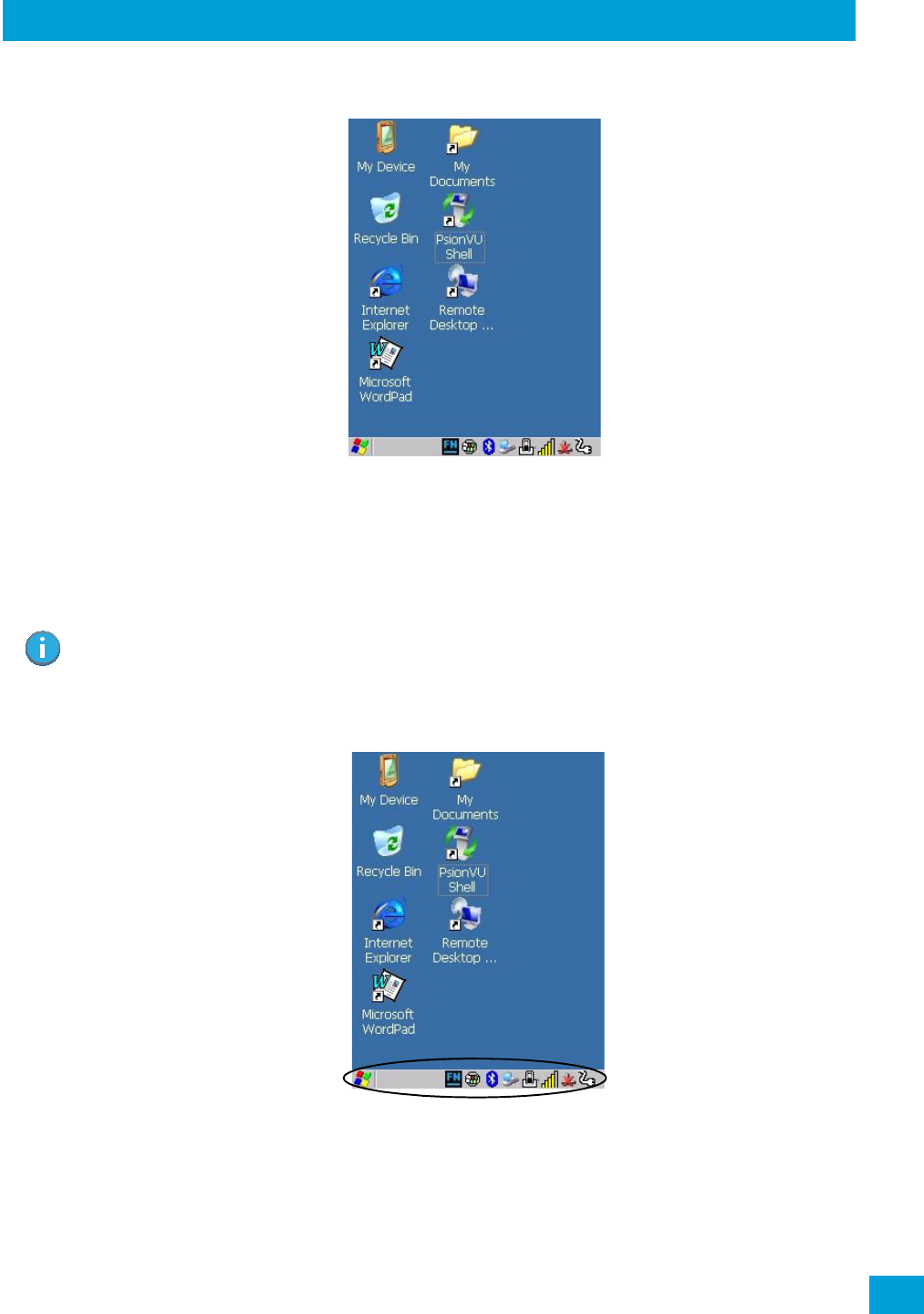
Chapter 3: Getting To Know Your Omnii
The Windows Classic Shell Startup Desktop
35
Psion Omnii Hand-Held Computer User Manual
Figure 3.5 Omnii Windows Classic Shell Startup Desktop
To access desktop icons:
• Double-tap on the icon to open a window or, in the case of an application icon, launch an application.
On the keyboard:
• Use the arrow keys to highlight the icon, and press [ENTER] to launch the highlighted icon.
3.8.2.1 The Taskbar
Omnii is equipped with a taskbar at the bottom of the screen. It displays icons through which you can view
the battery capacity and radio signal quality of your unit. If the hand-held is attached to a charger, cradle,
docking station, or Snap Module, an associated icon is displayed. In addition, the taskbar displays the appli-
cation(s) currently running on your unit.
The taskbar also displays active modifier keys: [SHIFT], [ALT], [CTRL], [FN] and [SYM]. Keys that have been
locked “on” are displayed with underlined letters. For example, if you have set the [CTRL] key lock to “on” in
Note: If the arrow keys do not highlight the desktop icons, the desktop may not be selected. Press
[Windows] to display the Start Menu, and select Desktop. Now the desktop will be “in focus”
and the arrow keys will highlight the icons.
Regulatory Draft
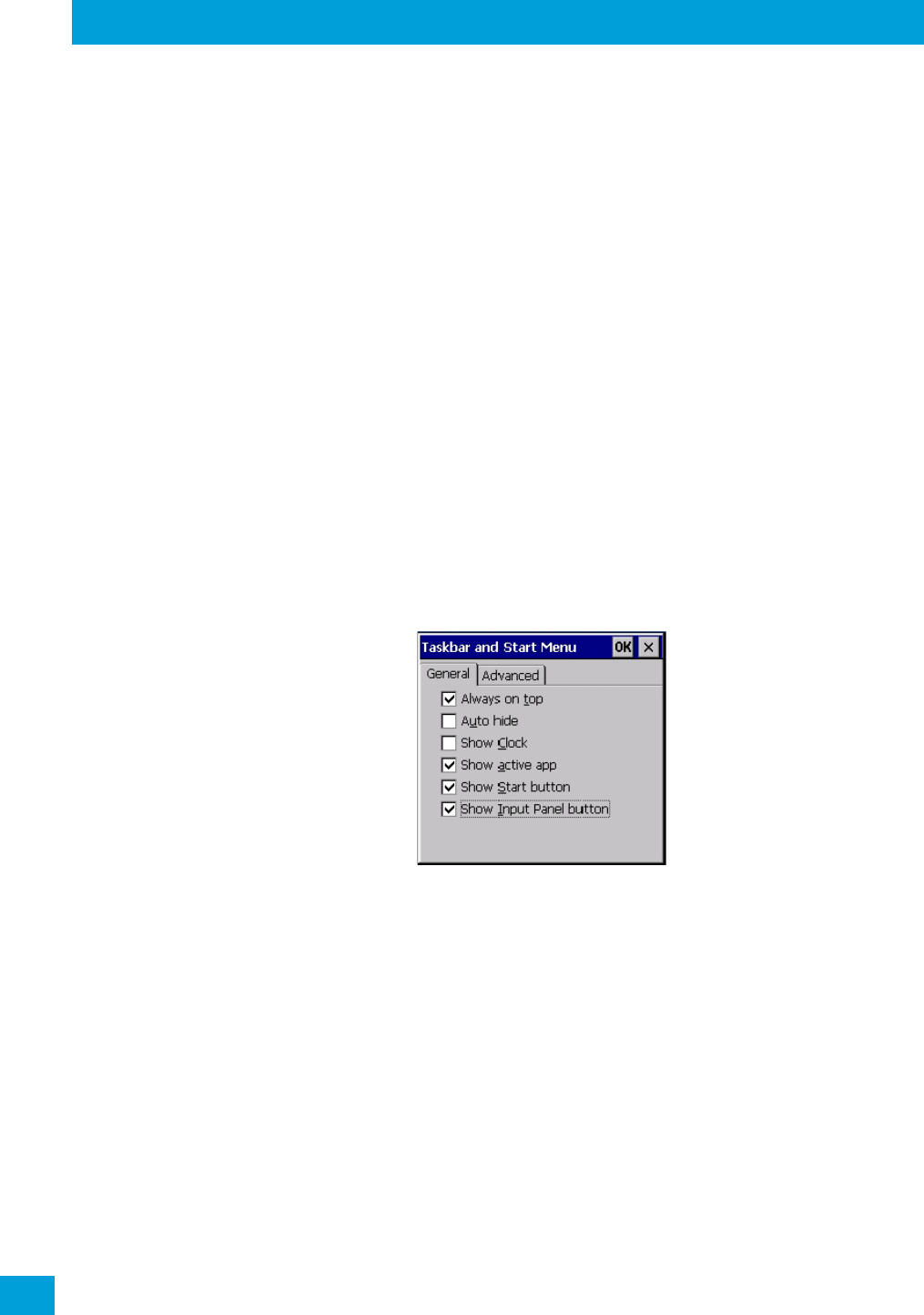
Chapter 3: Getting To Know Your Omnii
The Windows Classic Shell Startup Desktop
Psion Omnii Hand-Held Computer User Manual
36
the Keyboard menu and you press the key, it is displayed as an underlined ‘Ctrl’ in the taskbar. (For detailed
information on modifier keys and keyboard options, see “The Keyboard” on page 22).
3.8.2.1.1 Using the Taskbar
A tooltip is displayed as each taskbar icon is highlighted. The tooltip provides the status of each icon.
If you’re using the touchscreen:
• Tap and hold on an icon to display the icon's tooltip. Double-tap the icon to open the Control Panel
dialog box associated with the icon. For example, double-tap the battery icon to display a dialog box
listing the current battery capacity information.
On the keyboard:
•Press [Windows] to display the Start Menu.
•Choose Shortcuts from the Start Menu, and then press the [RIGHT] arrow key to display the sub-
menu.
•Choose System Tray in the sub-menu.
• Use the arrow keys to highlight the icon in the taskbar about which you’d like more information.
•Press [ENTER] to display the appropriate dialog box.
3.8.2.1.2 Customizing the Taskbar
To customize the taskbar so that it displays only those icons you require:
•In the Start Menu, choose Settings, and then Ta s kb ar .
If you’re using the keyboard:
•Press [Windows] to display the Start Menu.
• Highlight the Settings option, highlight Ta s kb a r in the sub-menu, and press [ENTER].
The Task bar a nd Start Men u dialog box is displayed.
• Tap on the items you want to activate or deactivate. The check mark indicates active items.
If you’re using the keyboard:
• Highlight the options you want to activate, and press the [SPACE] key to select them. A check mark
indicates active items.
3.8.2.2 The Start Menu
The Start Menu lists the operations you can access and work with. It is available from the startup desktop or
from within any application.
• To display the menu, tap on the Start Menu.
Regulatory Draft
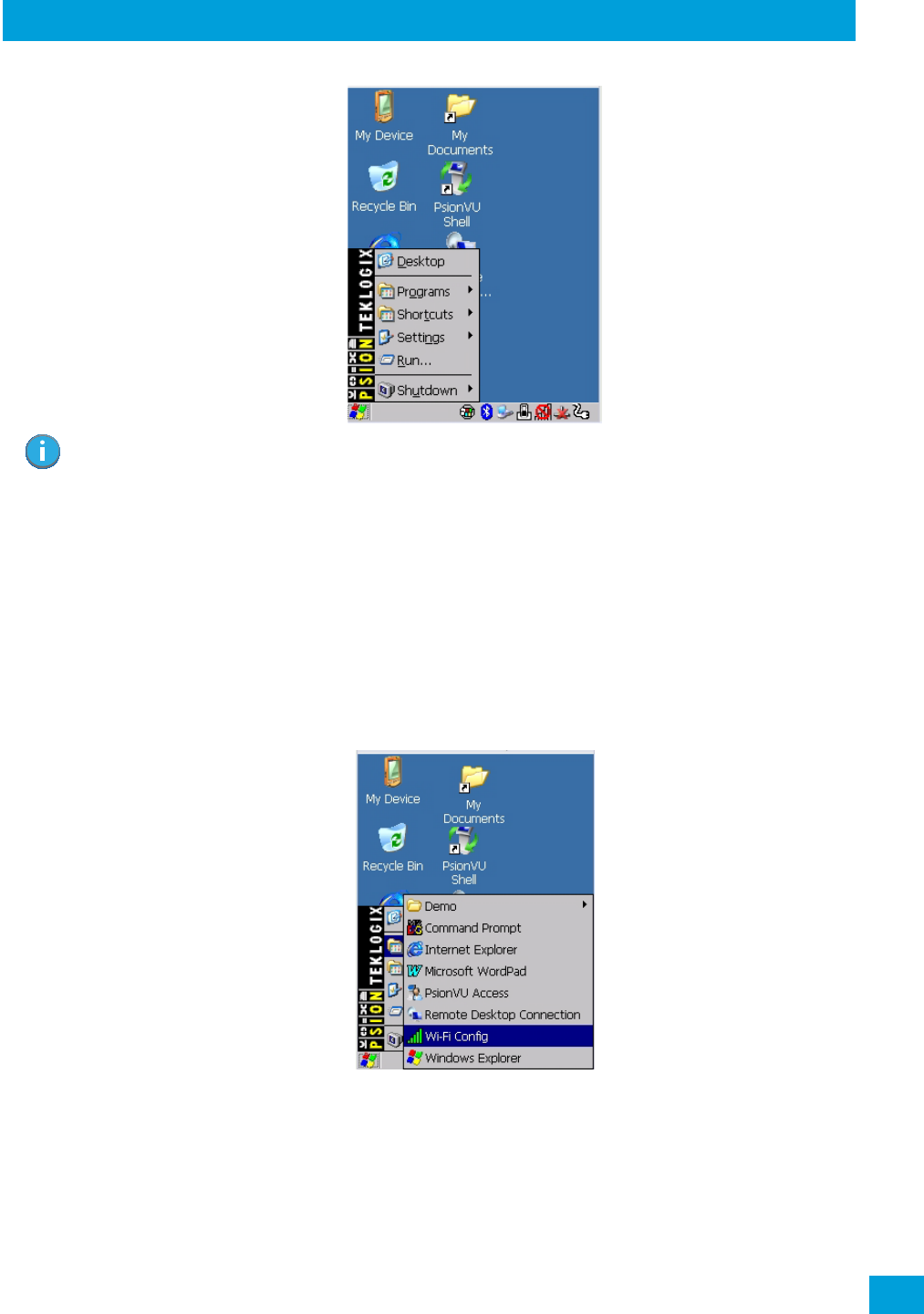
Chapter 3: Getting To Know Your Omnii
The Windows Classic Shell Startup Desktop
37
Psion Omnii Hand-Held Computer User Manual
If you’re using the keyboard:
• Use the arrow keys to highlight a menu item, and press [ENTER], or
If the menu item has an underlined character:
• Type the underlined alpha character. For example, to display the Run dialog box, type the letter ‘r’.
3.8.2.2.1 Programs
•Choose Programs to display a sub-menu of options. The programs displayed will be those resident in
the Windows\Programs folder of the computer.
Figure 3.6 Program Sub-Menu
This sub-menu allows you to choose Command Prompt, Internet Explorer, installed applications (e.g., Micro-
soft WordPad), PsionVU Access, Remote Desktop Connection, Wi-Fi Config, or Windows Explorer.
Demo
This folder contains the Scanner Demo, Demo Signature and Demo Sound applications. Scanner Demo can
be used to test how the hand-held reads and writes barcodes. Demo Signature allows you to capture a sig-
nature written on the screen with your stylus and save it to a file. Demo Sound allows you to record and
playback sound files. The ‘Sample Rate’ and the ‘Bits Per Sample’ are the rates at which the sound will be
Note: Tap on the item in the menu with which you want to work.
Regulatory Draft

Chapter 3: Getting To Know Your Omnii
The Windows Classic Shell Startup Desktop
Psion Omnii Hand-Held Computer User Manual
38
recorded. Sounds recorded at the higher sample rate or bits per sample will be higher quality sound but will
require more file storage space. Lower sample rates and/or bits per sample produces a smaller file, but the
sound quality suffers. The record and play buttons operate the same as any recording device. The X icon
deletes the sound and the diskette icon allows you to save your sound.
Command Prompt
Command Prompt is used to access the DOS command prompt. At the prompt, you can type DOS com-
mands such as dir to display all the directories in the drive.
Internet Explorer
Omnii is equipped with Microsoft Internet Explorer for Windows Embedded CE. You can access the Internet
Options icon through the Start Menu under Settings>Control Panel or by double-tapping on the desktop
icon My Device and then, double-tapping on the Control Panel icon.
Microsoft WordPad
WordPad is a basic word processor used to create, edit, and print .rtf, .doc, and .txt files.
PsionVU Access
PsionVU Access allows you to change the appearance and actions of the desktop from the default Windows
Classic Shell to the PsionVU shell.
Remote Desktop Connection
Remote Desktop Connection is an Omnii application used to connect to a Windows Terminal Server so that
you can run a “session” on the Server machine using the hand-held (Windows Embedded CE device).
“Remote Desktop Connection” on page 98 provides a website with details about this option.
Wi-Fi Config
The Wi-Fi Config application is used to configure the Omnii 802.11b/g radio for one or more wireless network
profiles.
Windows Explorer
The Windows Explorer installed on your Omnii is consistent with all Windows Embedded CE devices.
3.8.2.2.2 Shortcuts
Figure 3.7 Shortcuts Sub-Menu
System Tray
If your touchscreen is not enabled, you can use the System Tray option to access the icons in the taskbar at
the bottom of the screen. The taskbar displays indicators such as a radio signal icon. These indicators are
attached to dialog boxes that provide additional information.
•Choose Shortcuts>System Tray.
Regulatory Draft
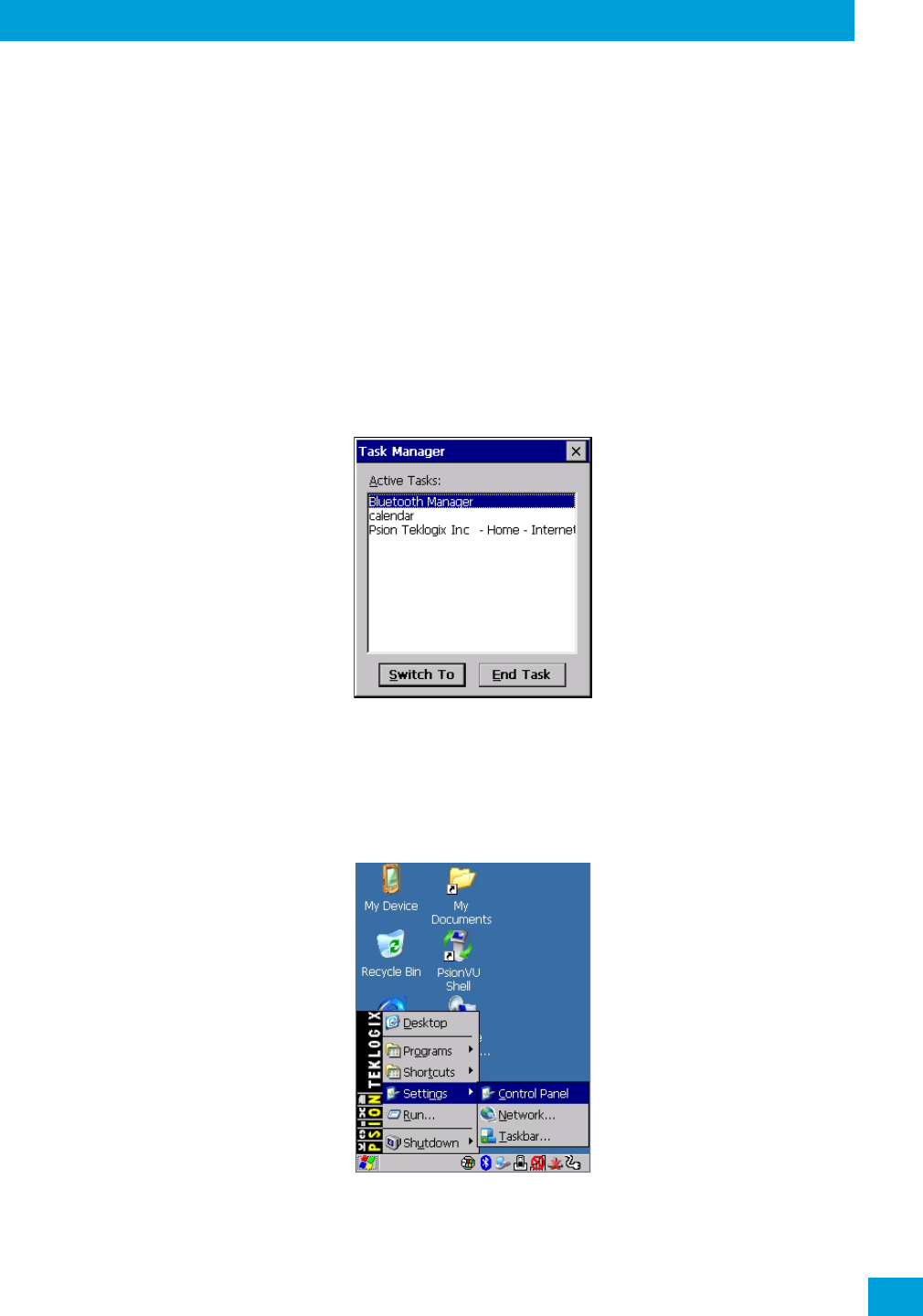
Chapter 3: Getting To Know Your Omnii
The Windows Classic Shell Startup Desktop
39
Psion Omnii Hand-Held Computer User Manual
When System Tray is chosen, the taskbar icons become accessible. To display the dialog box attached to an
icon:
• Use the arrow keys to highlight an icon, for example, the Bluetooth icon.
• Press [ENTER] to display the Bluetooth menus.
Cycle Tasks
When Cycle Tasks is selected (and the Task Manager is not open), you can cycle through active applications.
To cycle through your active applications:
•Choose Shortcuts>Cycle Tasks, or
• Press [ALT] [TAB].
Task M ana g e r
The Task Man a g er allows you to switch to another task or to end an active task. To display the task manager
window:
•Tap on Shortcuts>Task Manager, or
• Press [ALT] [ESC].
3.8.2.2.3 Settings
The Settings sub-menu includes the following settings: Control Panel, Network and Dial-up Connections
and Taskbar and Start Menu.
Figure 3.8 Settings Sub-Menu
Regulatory Draft
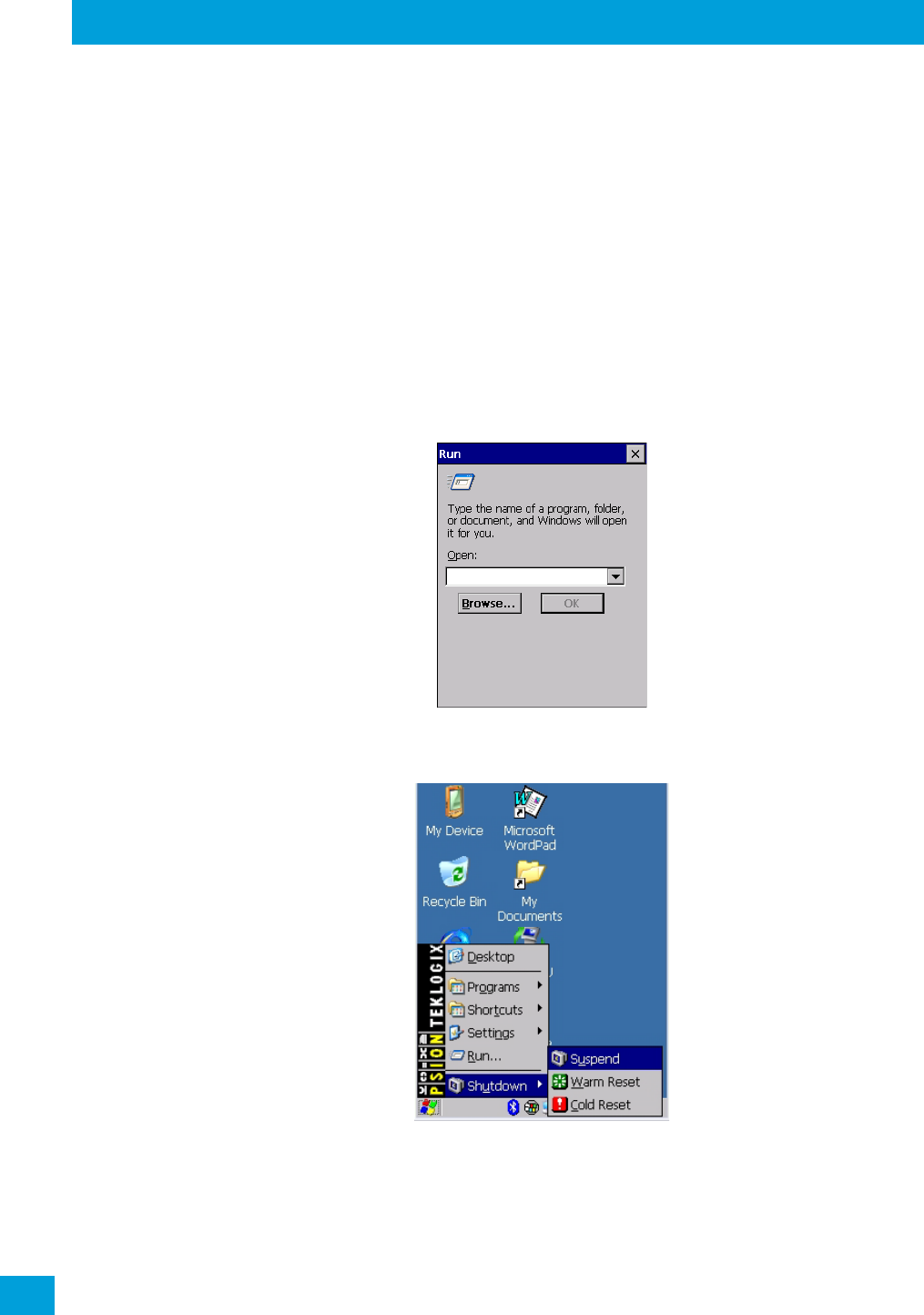
Chapter 3: Getting To Know Your Omnii
The Windows Classic Shell Startup Desktop
Psion Omnii Hand-Held Computer User Manual
40
Control Panel
The Control Panel contains applets used to configure hardware, the operating system and the shell. If your
Omnii is running with the Psion Open TekTerm application or another application, additional configuration
applets may appear in the Control Panel.
Network and Dial-Up Connections
The Network and Dial-up Connections window allows you to configure the Omnii network interfaces or
execute an existing configuration. Refer to “Connectivity” on page 17 for radio setup details.
Taskbar and Start Menu
The Task bar a nd Start Men u option displays a dialog box in which you can customize the taskbar, choosing
which options will be displayed. Refer to “Customizing the Taskbar” on page 36 for additional details about
this option.
3.8.2.2.4 Run
Choosing the Run option from the Start Menu displays a dialog box in which you can enter the name of the
program, folder or document you want to open or launch.
3.8.2.2.5 Shutdown
The Shutdown menu includes these options: Suspend, Warm Reset and Cold Reset.
Suspend
The Suspend option suspends Omnii immediately. This is equivalent to turning the hand-held off.
Warm Reset
The Warm Reset option resets the hand-held, leaving all saved files and registry settings intact. Any
unsaved data is lost.
Regulatory Draft
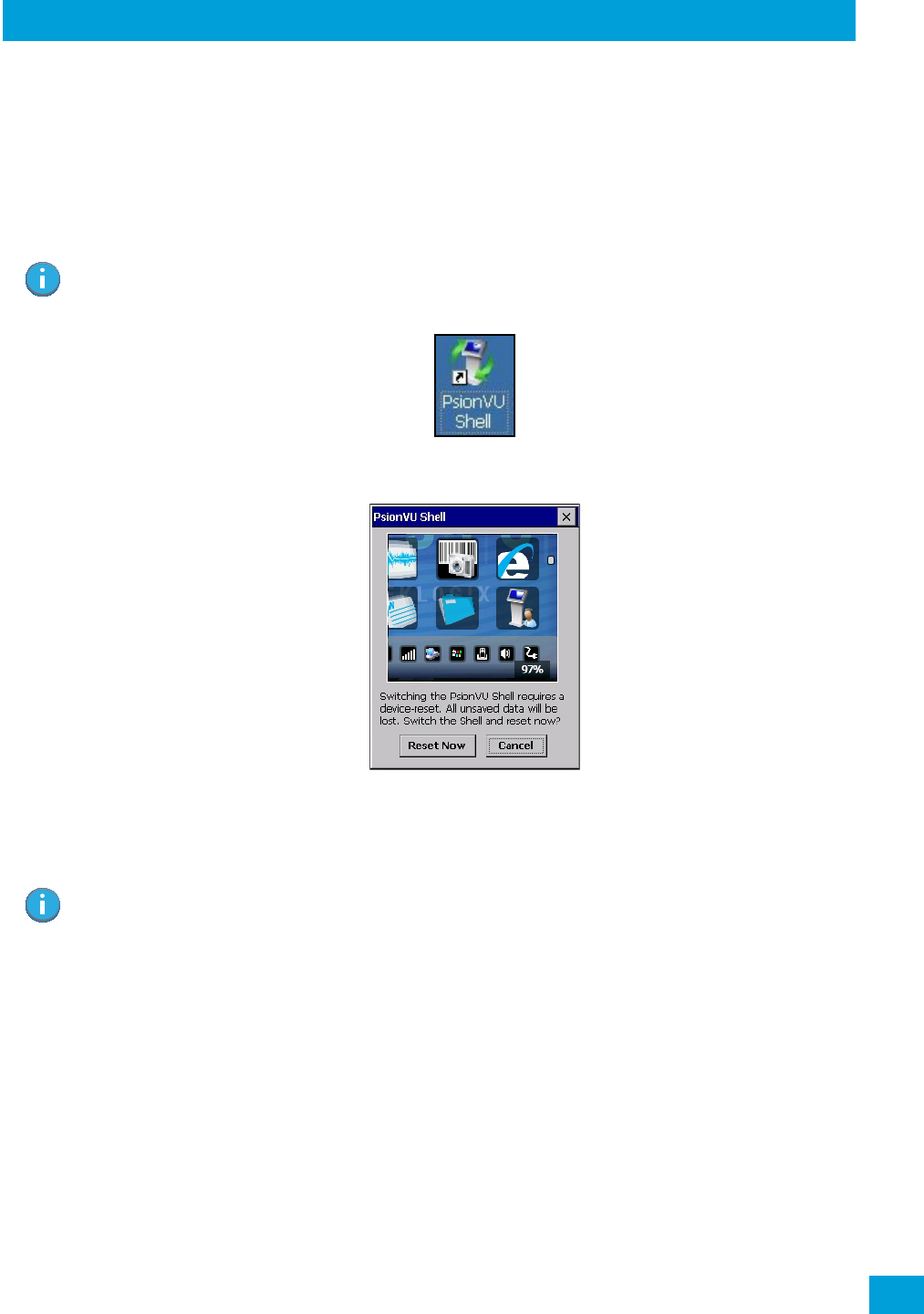
Chapter 3: Getting To Know Your Omnii
The PsionVU Desktop Shell
41
Psion Omnii Hand-Held Computer User Manual
Cold Reset
The Cold Reset option resets the hand-held (see page 16). Any files not stored in permanent memory are
lost; however, the registry settings are saved.
3.9 The PsionVU Desktop Shell
The appearance and actions of the desktop can be changed by tapping on the PsionVU Shell icon on your
desktop, which activates the PsionVU shell.
Figure 3.9 Switch to PsionVU Shell
After resetting the Omnii, the desktop appearance will be very different. The programs are accessed with
finger (or stylus) taps and swipes. If there are more applications than shown on one screen, a white ani-
mated dot will be present on the side of the screen in the direction of the next set of icons. Swiping the
screen to that direction will move the display to the next screen.
Note: Omnii will be reset if you choose to switch shells.
Note: Although the Desktop appearance defaults to the “Ingenuity” theme, the theme is not
changed using the PsionVU Shell icon. To change themes, open the Shell Settings>Advanced
menu in PsionVU Access (see “Shell Settings” on page 94).
Regulatory Draft
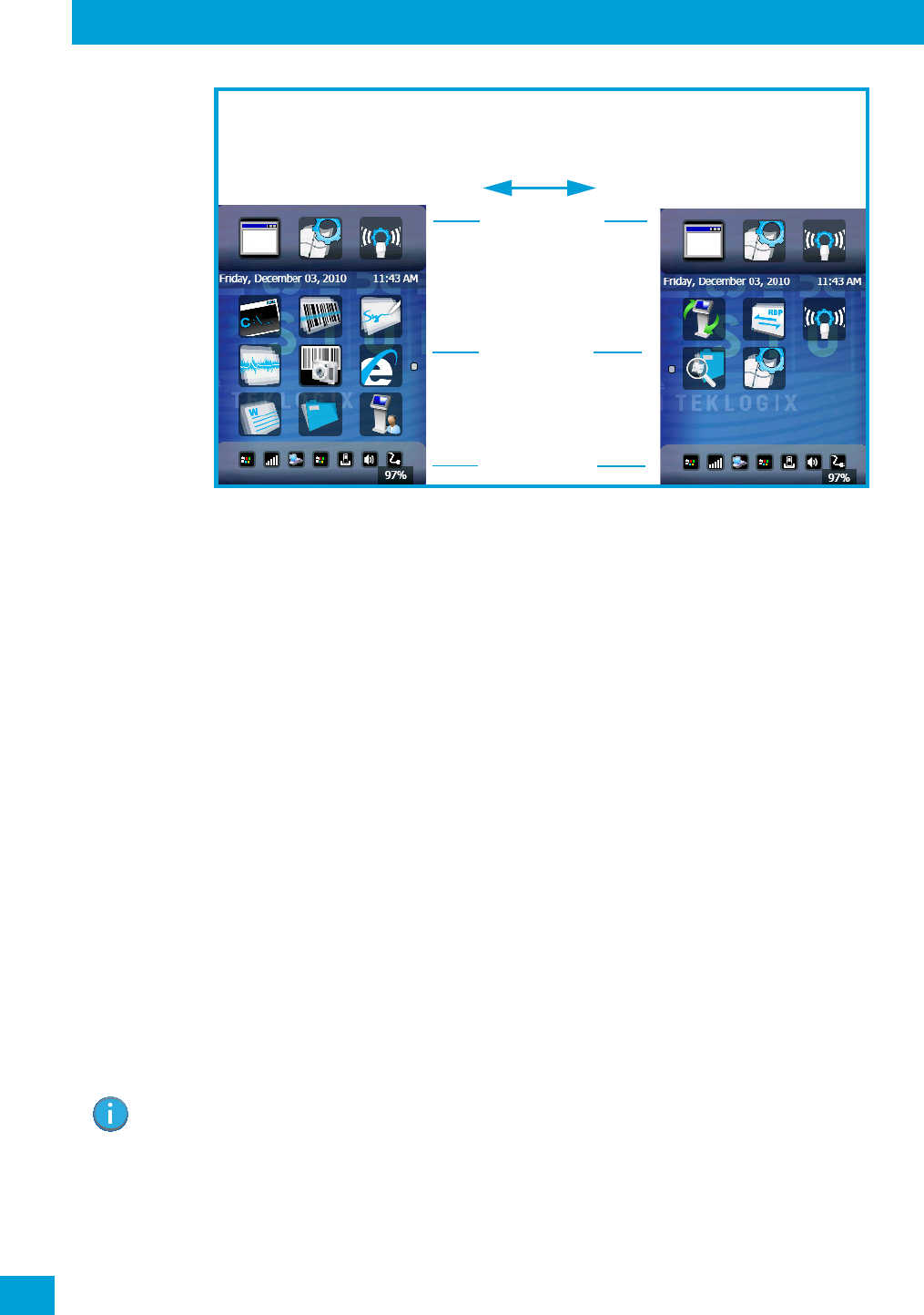
Chapter 3: Getting To Know Your Omnii
The PsionVU Desktop Shell
Psion Omnii Hand-Held Computer User Manual
42
A different program, PsionVU Access, enables you to customize your computer settings, remove or add
shortcuts to the Favourites Bar and Control Panel, and limit access to various different components on the
computer and the system tray icons for security. For details see “PsionVU Access” on page 93. To change
your Desktop background, refer to “Shell Settings” on page 94.
Active Tasks Bar
Open applications are shown in the top bar—the most recently opened is the first icon on the left. Tapping
once on a program icon will maximize the application. This feature replaces the Task Manager of the
Windows Classic Shell.
Date/Time Bar
Tapping once on the date or time will open the Date/Time Properties settings to enable you to change your
settings and time zone.
Favourites Bar
The Favourites Bar replaces the Windows Classic Shell’s Desktop and Start Menu. These icons are the
program shortcuts from your Windows>Start Menu. Tapping once will open the program. If you tap and hold
on an icon, the application name is displayed.
Notifications Bar
This bar shows the run-time program notifications for Battery, Volume, Wi-Fi, Phone or GPRS, and other no-
tifications for the programs you are running. This feature replaces the Taskbar of the Windows Classic
Shell.
Desktop Minimized View
When an application is opened and maximized, the desktop view is minimized and the Notifications Bar is
shown at the bottom of the screen. Tapping anywhere on the Notifications Bar (except on the SIP) will
restore the PsionVU desktop.
PsionVU Access
The PsionVU Access program allows you to open a different program, PsionVU, which enables you to cus-
tomize your computer settings, remove or add shortcuts to the Favourites Bar and Control Panel, and limit
access to various different components on the computer and the system tray icons for security. For details
Hold the stylus or your finger on the Active Tasks, Favourites, or Notifications Bar,
Favourites Bar
Notifications Bar
Active Tasks Bar
and swipe to the left or right to switch to the next screen.
Note: In order to use the SIP, turn on the automatic settings in Control Panel>Input Panel.
Regulatory Draft
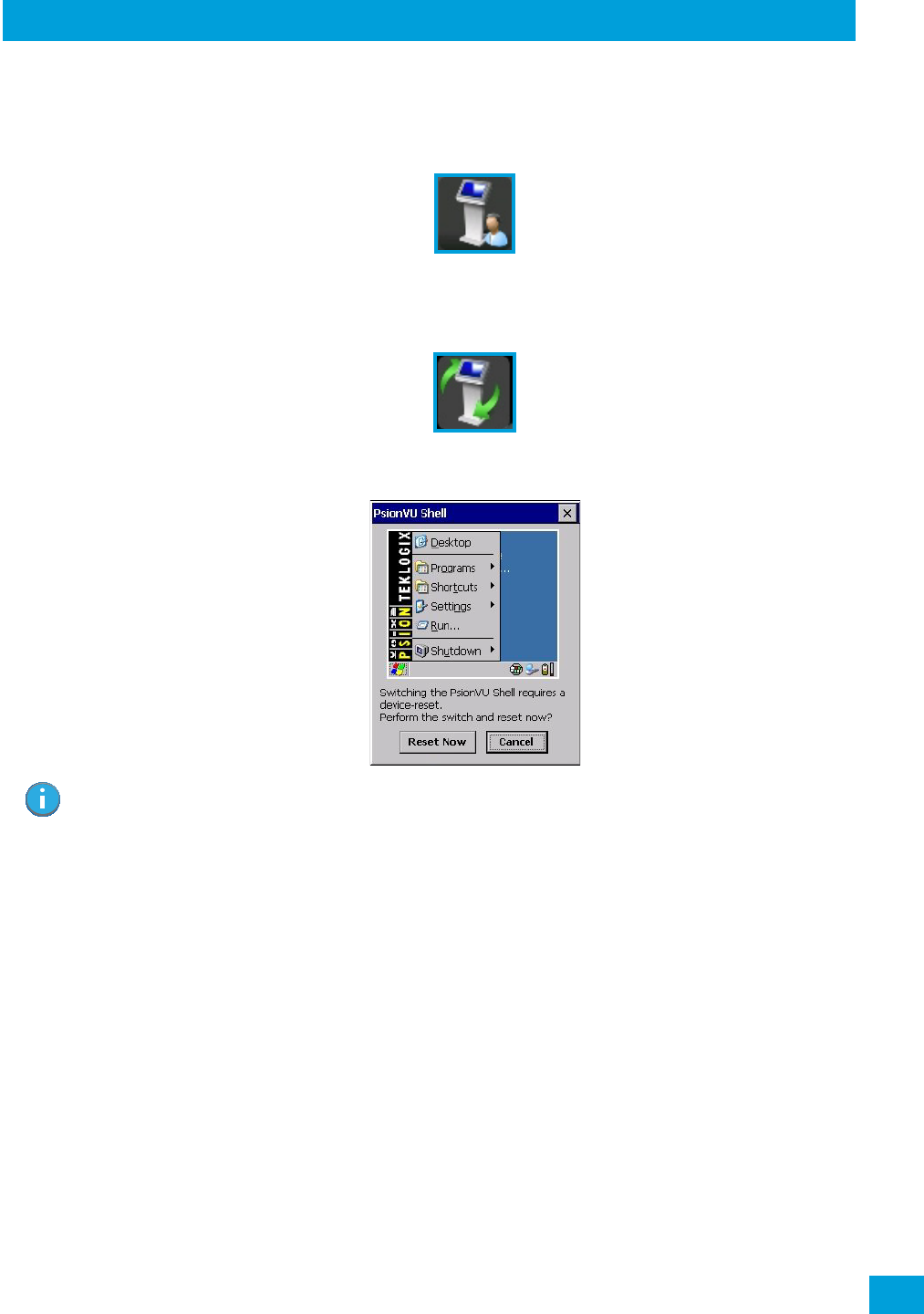
Chapter 3: Getting To Know Your Omnii
Restoring the Windows Classic Shell
43
Psion Omnii Hand-Held Computer User Manual
see “PsionVU Access” on page 93. To change your Desktop background, refer to “Shell Settings” on
page 94.
To open PsionVU:
•Tap on the PsionVU Access icon in the Favourites Bar.
3.9.1 Restoring the Windows Classic Shell
The default Desktop appearance and actions can be restored by tapping on the PsionVU Shell icon in the
Favourites Bar.
Figure 3.10 Shell Switch to Windows Classic Shell Desktop
3.10 General Maintenance
3.10.1 Caring for the Touchscreen
The touchscreen is covered with a thin, flexible polyester plastic sheet with a conductive coating on the
inside. The polyester can be permanently damaged by harsh chemicals and is susceptible to abrasions and
scratches. Using sharp objects on the touchscreen can scratch or cut the plastic, or crack the internal con-
ductive coating. The chemicals listed below must not come into contact with the touchscreen:
•mustard
• ketchup
• sodium hydroxide
•concentrated caustic solutions
• benzyl alcohol
•concentrated acids
If the touchscreen is used in harsh environments, consider applying a disposable screen protector (ST6112).
These covers reduce the clarity of the display slightly but will dramatically extend the useful life of the
touchscreen. When they become scratched and abraded, they are easily removed and replaced.
Note: Omnii will be reset if you choose to switch shells.
Regulatory Draft

Chapter 3: Getting To Know Your Omnii
Cleaning Omnii
Psion Omnii Hand-Held Computer User Manual
44
3.10.2 Cleaning Omnii
• Use only mild detergent or soapy water to clean the hand-held unit.
• Avoid abrasive cleaners, solvents or strong chemicals for cleaning. Omnii has a plastic case that is sus-
ceptible to harsh chemicals. The plastic is partially soluble in oils, mineral spirits and gasoline. The
plastic slowly decomposes in strong alkaline solutions.
• To clean ink marks from the keypad and touchscreen, use isopropyl alcohol.
Important: Do not immerse the unit in water. Dampen a soft cloth with mild detergent to wipe
the unit clean.
To prevent damage to the touchscreen, use only your finger or the stylus (pen)
supplied with your Omnii.
Regulatory Draft